The History Book Club discussion

This topic is about
Staying On
HISTORY OF SOUTHERN ASIA
>
GLOSSARY - STAYING ON - THE RAJ QUARTET SERIES~ (Spoiler Thread)
 Mahatma Gandhi
Mahatma Gandhi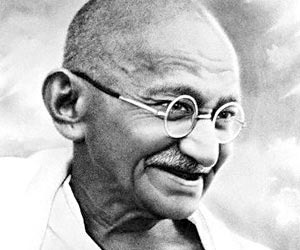
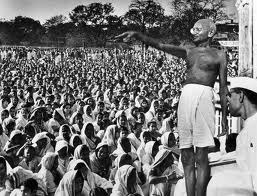
Known as 'Mahatma' (great soul), Gandhi was the leader of the Indian nationalist movement against British rule, and is widely considered the father of his country. His doctrine of non-violent protest to achieve political and social progress has been hugely influential.
Mohandas Karamchand Gandhi was born on 2 October 1869 in Porbandar in Gujarat. After university, he went to London to train as a barrister. He returned to India in 1891 and in 1893 accepted a job at an Indian law firm in Durban, South Africa. Gandhi was appalled by the treatment of Indian immigrants there, and joined the struggle to obtain basic rights for them. During his 20 years in South Africa he was sent to prison many times. Influenced primarily by Hinduism, but also by elements of Jainism and Christianity as well as writers including Tolstoy and Thoreau, Gandhi developed the satyagraha ('devotion to truth'), a new non-violent way to redress wrongs. In 1914, the South African government conceded to many of Gandhi's demands.
Gandhi returned to India shortly afterwards. In 1919, British plans to intern people suspected of sedition - the Rowlatt Acts - prompted Gandhi to announce a new satyagraha which attracted millions of followers. A demonstration against the acts resulted in the Amritsar Massacre by British troops. By 1920, Gandhi was a dominant figure in Indian politics. He transformed the Indian National Congress, and his programme of peaceful non-cooperation with the British included boycotts of British goods and institutions, leading to arrests of thousands.
In 1922, Gandhi himself was sentenced to six years' imprisonment. He was released after two years and withdrew from politics, devoting himself to trying to improve Hindu-Muslim relations, which had worsened. In 1930, Gandhi proclaimed a new campaign of civil disobedience in protest at a tax on salt, leading thousands on a 'March to the Sea' to symbolically make their own salt from seawater.
In 1931, Gandhi attended the Round Table Conference in London, as the sole representative of the Indian National Congress, but resigned from the party in 1934 in protest at its use of non-violence as a political expedient. He was replaced as leader by Jawaharlal Nehru.
In 1945, the British government began negotiations which culminated in the Mountbatten Plan of June 1947, and the formation of the two new independent states of India and Pakistan, divided along religious lines. Massive inter-communal violence marred the months before and after independence. Gandhi was opposed to partition, and now fasted in an attempt to bring calm in Calcutta and Delhi. On 30 January 1948, he was assassinated in Delhi by a Hindu fanatic.
(Source: http://www.bbc.co.uk/history/historic...)
More:
http://www.mkgandhi.org/
http://www.sscnet.ucla.edu/southasia/...
http://www.historylearningsite.co.uk/...
http://history1900s.about.com/od/peop...
http://www.gandhiinstitute.org/
http://www.jmu.edu/gandhicenter/
 by Louis Fischer (no photo)
by Louis Fischer (no photo) by Joseph Lelyveld (no photo)
by Joseph Lelyveld (no photo) by Dennis Dalton (no photo)
by Dennis Dalton (no photo) by Mark Shepard (no photo)
by Mark Shepard (no photo) by Michael Scott (no photo)
by Michael Scott (no photo) by
by
 Mahatma Gandhi
Mahatma Gandhi by
by
 Mahatma Gandhi
Mahatma Gandhi by
by
 Stanley Wolpert
Stanley Wolpert by
by
 Mahatma Gandhi
Mahatma Gandhi
 The British Raj
The British Raj
British involvement in India started with the East India Company, a chartered company of London merchants which gradually transformed trading privileges in Asia into a territorial empire centred on India. By 1700 it had secured important trading ports in, Madras, Bombay, and Calcutta, which became the capital of British India. Anglo-French hostility in the mid-18th century meant a struggle for supremacy with the French East India Company, the English commander Robert Clive, out-manoeuvered the French in south India, leaving them with just a few small enclaves. In 1756 the Prince of Bengal captured the company's trading station at Calcutta and put the 146 Europeans he caught into the prison cell known as the Black Hole of Calcutta. Only 23 survived the night. Clive defeated the Prince at the Battle of Plassey in 1757 securing Bengal for the Company. This made the East India Company the greatest European trader in India. Increasingly the company acted as an instrument of colonial government serving as Britain's administrators in India. In 1774 Warren Hastings, Governor of Bengal, was made the first Governor General of India. The Indian Mutiny of 1857 caused the India Acts, which transferred control of India from the company to the British government in 1858. This was the time when the Hindi term ‘Raj’ meaning rule came to prominence. The East India Company was finally dissolved in 1873.
Indian Mutiny
The Indian Mutiny started at Meerut in May 1857 when Sepoys in the army of the East India Company, refused to handle new cartridges apparently greased with pig and cow fat, insulting to Muslims and Hindus respectively. It spread rapidly to Delhi and soon included most regiments of the Bengal army and a large section of the civilian population. The mutiny spread to Lucknow, which was besieged, and to Cawnpore, where the massacre of the British garrison, including the wives and children, took place. The recapture of Delhi in September 1857 by the loyalist Sikhs and British reinforcements broke the back of the mutiny, and the rebels were beaten in 1858. Following the restoration of British control, the East India Company's rule was replaced by that of the British Government.
On 1st January 1877 Queen Victoria was proclaimed Empress of India at a Durbar, or assembly of notables and princes, in Delhi. The Sovereign, who incidentally never visited her Indian Empire, was represented by the Viceroy Lord Lytton. The Queen sent a telegram, which read;
' We, Victoria, by the grace of God, Empress of India, and through our Viceroy, to all our officers, civil and military, and to all princes, chiefs, and peoples now at Delhi assembled, send our Royal and Imperial greeting, and assure them of the deep interest and earnest affection with which we regard the people of our Indian Empire. We have witnessed with heartfelt satisfaction the reception they have accorded to our beloved son, and have been touched by their loyalty and attachment to our House and Throne.
We trust the present occasion may tend to unite in bonds of yet closer affection ourselves and our subjects, that from the highest to the humblest all may feel that under our rule the great principles of liberty, equity and justice are secured to them, and that to promote their happiness, to add to their prosperity, and advance their welfare, are the ever-present aims and objects of our Empire'.
The Princely States
The Princely States, bound by treaty to the crown, preserved control over their domestic affairs. Control over the directly ruled territories (about three fifths of the total area) was exercised by the Secretary of State for India. The Sovereign being represented by a Governor General or Viceroy, who being assisted by a council ruled India. The administration was staffed by the Indian Civil Service. The Indian Army, with British officers in charge ensured the Raj's security in conjunction with a British Army garrison. The Raj ended in 1947 with the partitioning and subsequent granting of independence to India and Pakistan on 15th August 1947.
The Princely States numbered more than 500 during the British Raj and although their rulers preserved some autonomy they were bound by treaty to the British. The states, although scattered, made up two fifths of India's territory. Their princes were of many faiths, mainly Hindu and Muslim. Many ruled dictatorially, but a few were more democratic. Many states had been forced to accept indirect British rule during the expansion and eventual control of The East India Company during 1757 to 1857. Mutual rivalries prevented much resistance to British overall control. After 1857, when control of India passed to the British Government, their autonomy was confirmed under British auspices. On Independence in 1947, they came under pressure to join either India or Pakistan. Most acceded peacefully, hoping some of their privileges, would be upheld. Many of the smaller states were grouped together into unions, an example being Rajasthan. Their privileged status was abolished in 1970.
Mahatma Gandhi
Mohandas Karamchand Gandhi, was educated in India and Britain, qualifying as a barrister in London. He practised law briefly in India, but moved to South Africa in 1893 until 1914, where he became a successful lawyer. There he developed his technique of satyagraha meaning 'truth-force' or non-violent resistance to obtain equal rights for Indians in South Africa which met with some success. Returning to India, he formed political connections and led Indian nationalists in a series of confrontations with the British Raj. From 1920 he dominated the Indian National Congress, founded in 1885 as an annual meeting of educated Indians who desired a greater share in the government of the Raj. Gandhi initiated the decision by Congress to promote a policy of non-co-operation with the Raj, causing himself frequent prison terms. He led various other campaigns of civil disobedience during the 1930’s and 40’s including the ‘Quit India’ campaign of 1942. With independence for India imminent, he co-operated with the British despite his opposition to partition of India. Gandhi turned the small, upper-middle-class Indian National Congress into a mass movement by adopting a style that would appeal to ordinary Hindus and by creating networks of alliances with other political movements. His acceptance of partition and concern over the treatment of Muslims in India made him enemies among extremist Hindus. He was assassinated in Delhi in 1948. Widely revered before and after his death, he was known as the ‘Mahatma’ meaning 'Great Soul' in Sanskrit.
Partition
Before independence it was agreed to partition the 'Raj' because of disagreeing political and religious factions. Fear of persecution after independence caused mass movements of people with Moslems in India heading to Pakistan, and Hindus from Pakistan to India. The areas which form present day Pakistan and Bangladesh were predominately Moslem. Border disputes and wars have hampered the area since. The relations between Pakistan and India remain strained.
(Source: http://freespace.virgin.net/andrew.ra...)
More:
http://en.wikipedia.org/wiki/British_Raj
http://www.bbc.co.uk/history/british/...
http://en.wikipedia.org/wiki/List_of_...
http://www.theguardian.com/artanddesi...
http://www.flowofhistory.com/units/em...
http://www.nationalarchives.gov.uk/ed...
(no image) The Holocaust of Indian Partition: An Inquest by Madhav Godbole (no photo)
(no image) Islamic Law As Administered In British India And In The Joint British Courts In The Arabian Gulf ;1857 1947 / Salim A. Al by Arrayed bSalim A Arrayed (no photo)
 by Lawrence James (no photo)
by Lawrence James (no photo) by Byron Farwell (no photo)
by Byron Farwell (no photo) by David Page (no photo)
by David Page (no photo) by Mohammad Iqbal Chawla (no photo)
by Mohammad Iqbal Chawla (no photo) by Roy Douglas (no photo)
by Roy Douglas (no photo) by Roderick Cavaliero (no photo)
by Roderick Cavaliero (no photo) by Piers Brendon (no photo)
by Piers Brendon (no photo)
 Anglo-Indians
Anglo-Indians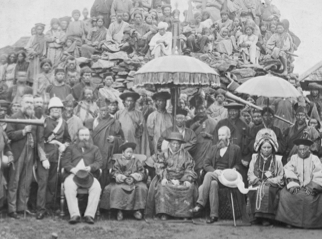
Anglo-Indians are people who have mixed Indian and British ancestry, or people of British descent born or living in the Indian Subcontinent or Burma, now mainly historical in the latter sense. British residents in India used the term "Eurasians" for people of mixed European and Indian descent. The Oxford Dictionary's definition of "Anglo-Indian" is "Of mixed British and Indian parentage, of Indian descent but born or living in Britain, or (chiefly historical) of British descent or birth but living or having lived long in India".
The Anglo-Indian community in its modern sense is a distinct, small minority community originating in India. It consists of people from mixed British and Indian ancestry whose native language is English. An Anglo-Indian's British ancestry was usually bequeathed paternally.
Article 366(2) of the Indian Constitution defines Anglo-Indian as
(2) an Anglo Indian means a person whose father or any of whose other male progenitors in the male line is or was of European descent but who is domiciled within the territory of India and is or was born within such territory of parents habitually resident therein and not established there for temporary purposes only;
Anglo-Indian often only represents Indians mixed with British ancestry during the British Raj. There's many mixed Indians from European countries other than the British, that were involved in the British Raj, for example, the definition rarely embraces the descendants of the Indians from the old Portuguese colonies of both the Coromandel and Malabar Coasts, who joined the East India Company as mercenaries and brought their families with them. The definition has many extensions, for example, mestiços (mixed Portuguese and Indian) of Goa, people of Indo-French descent, and Indo-Dutch descent. Indians have came across Europeans since the start of the Early Civilization, that continuously brought diversity to the country, these Indians would not be considered Anglo-Indians, similarly, Indians that mixed with Europeans after the British Raj would also not be considered Anglo-Indian.
Anglo-Indians formed a significant portion of the minority community in India during the British Raj. The Anglo-Indian population in India dwindled from roughly 800,000 in 1947 to fewer than 350,000 by 2010. Many have adapted to local communities and emigrated to the United Kingdom, Australia, Canada, and United States. In June 2013, it was established through DNA testing that Prince William, Duke of Cambridge, second in line to the British throne, has descended from an Indian woman on his mother's side, thus making him Anglo-Indian. (Source: http://en.wikipedia.org/wiki/Anglo-In...)
More:
http://newindianexpress.com/cities/ch...
http://www.bbc.co.uk/news/magazine-20...
http://www.nytimes.com/2010/08/15/wor...
http://www.movinghere.org.uk/gallerie...
http://www.anglo-indians.com/index.asp
http://www.margaretdeefholts.com/angl...
 by Errol O'Brien (no photo)
by Errol O'Brien (no photo) by S. Mitra (no photo)
by S. Mitra (no photo) by S Muthiah (no photo)
by S Muthiah (no photo) by Shirley Gifford-Pritchard (no photo)
by Shirley Gifford-Pritchard (no photo) by Shompa Lahiri (no photo)
by Shompa Lahiri (no photo) by Peter Moss (no photo)
by Peter Moss (no photo) by Patricia Brown (no photo)
by Patricia Brown (no photo)
 The Rowlatt Act
The Rowlatt Act
In February of 1919, the Imperial Legislative Council of British India gave India the Rowlatt Act. The Imperial Legislative Council passed this law so they could try certain cases without a jury decision, and detain people without a fair, proper trail. Mostly the Indian public disliked these acts because they were made to suppress their rights, and to make the British control even more powerful. One of the most influential figures at this time, Mahatma Gandhi, was particularly against these acts. In fact, he organized a protest movement that directly caused the Massacre of Amritsar in April of 1919, which was led by Brig. Gen. Reginald E.H. Dyer.
These acts consisted of two laws that permitted the British law enforcers to search and arrest anyone, to deny them a jury, and to detain them without a trail. In addition, these acts made it unlawful to organize opposition against the government. These acts demolished any possible positive impact that the British rule could have had on the India. In spite of these acts, it caused growth in the nationalist movement, and gave it a backing. Gandhi eventually took control over he movement and launched other many other civil disobedience campaigns and his new tactic of satyagraha.
These bills allowed for the great awakening of India’s independence from Britain. Gandhi’s first step was to go to Madras, where he was invited to explain the acts to a group of leaders. During this conference in Madras, they all received word that the acts had in fact passed. Gandhi’s next move was to organize a hatral to mark the beginning of his satyagraha movement. The hatral’s date was move to April 6th and the people of Bombay closed their doors to business.
Gandhi’s movement organized a series of peaceful demonstrations, yet some still broke out in violence, despite Gandhi’s requests to remain unprovoked by the British control. For example the Massacre at Amritsar, which took place in the open scenery of Jallianwalla Bahg. During this massacre, his troops open fired at an un-armed crowd of 10,000 that were peacefully, yet unlawfully protesting the Rotwall acts on April 13, 1919. The crowd went into sudden panic, as there was only one exit for the gathering area. It resulted in many deaths to the Indian population. This massacre was a direct result of the Rotwall acts. There were 379 suspected deaths and over 2,000 wounded, all of which were caused by the British soldiers under the control of Brig. Gen. Reginald E.H Dryer.
Following many of the brutal massacres, Gandhi went on a series of fasts to try to shock the public, and convince them to resort to non-violent resistance and non-cooperation instead of their violent tactics. As a response to the massacre, Gandhi went on a publicized three-day fast. As an opposition, Gandhi urged people to boycott all British made goods, law courts, and British education institutions.
Eventually, Gandhi was forced to call off the first nationwide satyagraha, because of these violent actions against he police that he did not support. Although Gandhi’s actions against the Acts were monumental, it could be that they were started too late to affect the shaping of them. The Rowlatt Acts brought a start to Gandhi’s fight for India’s independence, and brought Hindus and Muslims together because it gave his movement fuel to start his resistance against the British rule.
(Source: https://sites.google.com/site/incgand...)
More:
http://en.wikipedia.org/wiki/Rowlatt_Act
http://www.britannica.com/EBchecked/t...
https://sites.google.com/site/gandhi2...
http://www.indianetzone.com/14/the_ro...
http://vemulaveeru.blogspot.com/2012/...
http://www.mapsofindia.com/amritsar/m...
(no image) Police Power And Colonial Rule, Madras, 1859 1947 by David Arnold (no photo)
 by Tim Coates (no photo)
by Tim Coates (no photo) by Alfred Draper (no photo)
by Alfred Draper (no photo) by Constance Dejong (no photo)
by Constance Dejong (no photo) by Patrick O'Leary (no photo)
by Patrick O'Leary (no photo) by James K. Mathews (no photo)
by James K. Mathews (no photo)
 East India Company
East India Company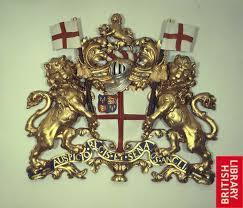
The East India Company (EIC), originally chartered as the Governor and Company of Merchants of London trading into the East Indies, and more properly called the Honourable East India Company, was an English and later (from 1707) British joint-stock company formed for pursuing trade with the East Indies but which ended up trading mainly with the Indian subcontinent, North-West Frontier Province and Balochistan.
The East India Company traded mainly in cotton, silk, indigo dye, salt, saltpetre, tea and opium. The Company was granted a Royal Charter by Queen Elizabeth in 1600, making it the oldest among several similarly formed European East India Companies. Shares of the company were owned by wealthy merchants and aristocrats. The government owned no shares and had only indirect control. The Company eventually came to rule large areas of India with its own private armies, exercising military power and assuming administrative functions. Company rule in India effectively began in 1757 after the Battle of Plassey and lasted until 1858 when, following the Indian Rebellion of 1857, the Government of India Act 1858 led to the British Crown assuming direct control of India in the era of the new British Raj.
The company was dissolved in 1874 as a result of the East India Stock Dividend Redemption Act passed one year earlier, as the Government of India Act had by then rendered it vestigial, powerless and obsolete. Its functions had been fully absorbed into the official government machinery of British India and its private presidency armies had been nationalised by the British Crown. (Source: http://en.wikipedia.org/wiki/East_Ind...
More:
http://www.sscnet.ucla.edu/southasia/...
http://www.victorianweb.org/history/e...
http://www.britannica.com/EBchecked/t...
http://www.bbc.co.uk/history/british/...
http://www.infoplease.com/encyclopedi...
http://www.bl.uk/reshelp/findhelpregi...
http://www.bloomberg.com/news/2013-03...
 by Brian Gardner (no photo)
by Brian Gardner (no photo) by Nick Robins (no photo)
by Nick Robins (no photo) by Philip Lawson (no photo)
by Philip Lawson (no photo) by Huw Bowen (no photo)
by Huw Bowen (no photo) by Barbara Harlow (no photo)
by Barbara Harlow (no photo) by Ramkrishna Mukherjee (no photo)
by Ramkrishna Mukherjee (no photo) by
by
 John Keay
John Keay
 Colonial India
Colonial India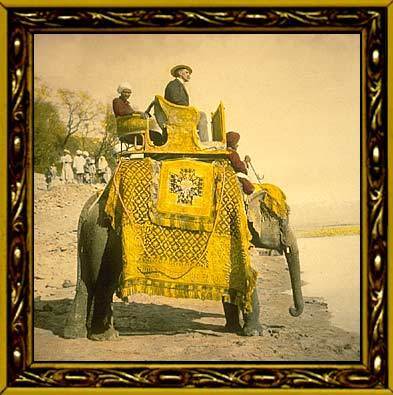
Colonial India is a part of the Indian subcontinent which was under the control of European colonial powers, through trade and conquest. The first European power to arrive in India was the army of Alexander the Great in 327–326 BC. The satraps he established in the north west of the subcontinent quickly crumbled after he left. Later, trade was carried between Indian states and the Roman Empire by Roman sailors who reached India via the Red Sea and Arabian Sea, but the Romans never sought trading settlements or territory in India. The spice trade between India and Europe was one of the main types of trade in the world economy and was the main catalyst for the period of European exploration. The search for the wealth and prosperity of India led to the accidental "discovery" of the Americas by Christopher Columbus in 1492. Only a few years later, near the end of the 15th century, Portuguese sailor Vasco da Gama became the first European to re-establish direct trade links with India since Roman times by being the first to arrive by circumnavigating Africa (1497–1499). Having arrived in Calicut, which by then was one of the major trading ports of the eastern world, he obtained permission to trade in the city from Saamoothiri Rajah.
Trading rivalries brought other European powers to India. The Netherlands, England, France, and Denmark established trading posts in India in the early 17th century. As the Mughal Empire disintegrated in the early 18th century and then the Maratha Empire became weakened after the third battle of Panipat, the relatively weak and unstable Indian states which emerged were increasingly open to manipulation by the Europeans through dependent "friendly" Indian rulers.
In the later 18th century Britain and France struggled for dominance through proxy Indian rulers and also by direct military intervention. The defeat of the redoubtable Indian ruler Tipu Sultan in 1799 marginalised French influence. This was followed by a rapid expansion of British power through the greater part of the subcontinent in the early 19th century. By the middle of the century, the British had already gained direct or indirect control over almost all of India. British India contained the most populous and valuable provinces of the British Empire and thus became known as "the jewel in the British crown". (Source: http://en.wikipedia.org/wiki/Colonial...)
More:
http://www.wmich.edu/dialogues/themes...
http://www.lib.berkeley.edu/SSEAL/Sou...
http://www.jstor.org/discover/10.2307...
http://www.victorianweb.org/history/e...
http://www.cambridge.org/us/academic/...
http://www.slideshare.net/jdrury/colo...
 by Manu Goswami (no photo)
by Manu Goswami (no photo) by Sanjay Joshi (no photo)
by Sanjay Joshi (no photo) by Douglas M. Peers (no photo)
by Douglas M. Peers (no photo) by Antoinette Burton (no photo)
by Antoinette Burton (no photo) by Elizabeth Kolsky (no photo)
by Elizabeth Kolsky (no photo) by Sanjay Joshi (no photo)
by Sanjay Joshi (no photo) by Eric Stokes (no photo)
by Eric Stokes (no photo) by Jyotsna Singh (no photo)
by Jyotsna Singh (no photo) by
by
 Ranajit Guha
Ranajit Guha
 Women in the Raj
Women in the Raj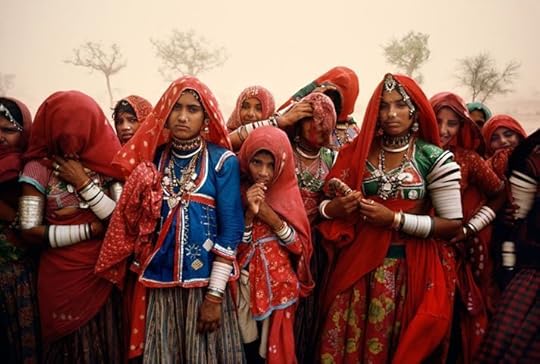
European scholars observed in the 19th century that Hindu women are "naturally chaste" and "more virtuous" than other women. During the British Raj, many reformers such as Ram Mohan Roy, Ishwar Chandra Vidyasagar, Jyotirao Phule, etc., fought for the betterment of women. Peary Charan Sarkar, a former student of Hindu College, Calcutta and a member of "Young Bengal", set up the first free school for girls in India in 1847 in Barasat, a suburb of Calcutta (later the school was named Kalikrishna Girls' High School).
While this might suggest that there was no positive British contribution during the Raj era, that is not entirely the case. Missionaries' wives such as Martha Mault née Mead and her daughter Eliza Caldwell née Mault are rightly remembered for pioneering the education and training of girls in south India. This practise initially met with local resistance, as it flew in the face of tradition. Raja Rammohan Roy's efforts led to the abolition of Sati under Governor-General William Cavendish-Bentinck in 1829. Ishwar Chandra Vidyasagar's crusade for improvement in the situation of widows led to the Widow Remarriage Act of 1856. Many women reformers such as Pandita Ramabai also helped the cause of women.
Kittur Chennamma, queen of the princely state Kittur in Karnataka, led an armed rebellion against the British in response to the Doctrine of lapse. Abbakka Rani, queen of coastal Karnataka, led the defence against invading European armies, notably the Portuguese in the 16th century. Rani Lakshmi Bai, the Queen of Jhansi, led the Indian Rebellion of 1857 against the British. She is now widely considered as a national hero. Begum Hazrat Mahal, the co-ruler of Awadh, was another ruler who led the revolt of 1857. She refused deals with the British and later retreated to Nepal. The Begums of Bhopal were also considered notable female rulers during this period. They did not observe purdah and were trained in martial arts.
Chandramukhi Basu, Kadambini Ganguly and Anandi Gopal Joshi were some of the earliest Indian women to obtain a degree.
In 1917, the first women's delegation met the Secretary of State to demand women's political rights, supported by the Indian National Congress. The All India Women's Education Conference was held in Pune in 1927. In 1929, through the efforts of Mahomed Ali Jinnah, the Child Marriage Restraint Act was passed, stipulating fourteen as the minimum age of marriage for a girl. Though Mahatma Gandhi himself married at the age of thirteen, he later urged people to boycott child marriages and called upon young men to marry child widows.
Women played an important part in India's independence struggle. Some famous freedom fighters include Bhikaji Cama, Dr. Annie Besant, Pritilata Waddedar, Vijayalakshmi Pandit, Rajkumari Amrit Kaur, Aruna Asaf Ali, Sucheta Kriplani and Kasturba Gandhi. Other notable names include Muthulakshmi Reddy and Durgabai Deshmukh. The Rani of Jhansi Regiment of Subhas Chandra Bose's Indian National Army consisted entirely of women, including Captain Lakshmi Sahgal. Sarojini Naidu, a poet and freedom fighter, was the first Indian woman to become President of the Indian National Congress and the first woman to become the governor of a state in India.
The status of women in India has been subject to many great changes over the past few millennia. From equal status with men in ancient times through the low points of the medieval period, to the promotion of equal rights by many reformers, the history of women in India has been eventful. In modern India, women have held high offices in India including that of the President, Prime Minister, Speaker of the Lok Sabha and Leader of the Opposition. As of 2011, the Speaker of the Lok Sabha and the Leader of the Opposition in the Lok Sabha (Lower House of the parliament) were women. However, women in India continue to face atrocities such as rape, acid throwing, dowry killings while young girls are forced into prostitution. According to a global poll conducted by Thomson Reuters, India is the "fourth most dangerous country" in the world for women, and the worst country for women among the G20 countries. (Source: http://en.wikipedia.org/wiki/Women_in...)
More:
http://myweb.tiscali.co.uk/kenanderso...
http://www.jstor.org/discover/10.2307...
http://pers-www.wlv.ac.uk/~le1810/4GK...
http://en.wikipedia.org/wiki/British_...
http://www.telegraph.co.uk/news/world...
http://www.academia.edu/2259773/Servi...
http://www.faqs.org/childhood/Bo-Ch/B...
 by Susie J. Tharu (no photo)
by Susie J. Tharu (no photo) by Rajeswari Sunder Rajan (no photo)
by Rajeswari Sunder Rajan (no photo) by Margaret MacMillan (no photo)
by Margaret MacMillan (no photo) by Shahida Lateef (no photo)
by Shahida Lateef (no photo) by Ritu Menon (no photo)
by Ritu Menon (no photo) by Pat Barr (no photo)
by Pat Barr (no photo) by Arun R. Kumbhare (no photo)
by Arun R. Kumbhare (no photo) by Zoya Hasan (no photo)
by Zoya Hasan (no photo) by Shaharyar M. Khan (no photo)
by Shaharyar M. Khan (no photo) by Joyce Chapman Lebra (no photo)
by Joyce Chapman Lebra (no photo)
 Christian Missionaries in British India
Christian Missionaries in British India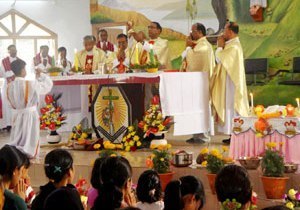
The claims of Christianity on Indian soil date back almost to the beginning of Christianity itself.
When European powers began to colonize the subcontinent in the early 1500's, Nestorian Christians were already scattered along India's southeast coast - especially in Goa and Kerala. They were referred to locally as "St. Thomas Christians"; although whether or not the apostle actually founded the church there is uncertain. They still exist today in Kerala in the form of 1.8 million Syrian Orthodox. When the Portuguese settled in Goa in 1510, one of their first orders of business was to convert the Nestorians to Roman Catholicism.
A Bishopric was established in 1534, and the Portuguese administration offered military protection from Muslim raiders to Nestorians who converted. As news of the tens of thousands of baptisms taking place reached Europe, a wave of Catholic Missions was initiated which included Francis Xavier. Xavier worked in Goa for five months, concentrating on the city's three prisons and its hospitals. Moving from Goa to the Coromandel Coast, Xavier translated the ten commandments and the Lord's Prayer (along with several Roman prayers) into pidgen Tamil and proceeded to baptize 10,000 converts in his first month.
While the Catholics were the only major force for missions in India for well over a century, their influence eventually died as a result of events in Europe and corruption in the church hierarchy. For most of the 1700's, missions were actively encouraged only in the small Danish colonies of Tranquebar and Serampore. Under the Danish Halle Mission, the first Lutheran missionaries left for Tranquebar in 1706 - Heinrich Plutschau and Bartholomaes Ziegenbalg. Both learned Tamil quickly and worked at scripture translation, eventually completing a Tamil New Testament. Ziegenbalg spent four months in an English prison as a result of his work. Plutschau returned to Europe in 1711; Ziegenbalg, after making at least 350 converts in his last year of ministry, died in Tranquebar in 1719. The Halle Mission continued for another 120 years.
While Anglican clergy existed for the care of British citizens, British Missions in India didn't begin until near the end of the 18th century; even then it was on Danish soil. William Carey, being denied permission to work in Calcutta, was forced to remove himself in 1799 to the nearby Danish colony of Serampore. (Missionaries were finally allowed restricted access to British India in 1813 and unrestricted access in 1833 - the year before Carey died.) Carey worked in evangelism, education, scripture translation and social reform, along with William Ward and Joshua Marshman. They translated portions of the Bible into no less than 36 languages, and established two important principles in Protestant missions: the equality of missionaries and new converts, and that missions should strive to be self sustaining.
Besides seeing British India open to Missions, one of Carey's greatest triumphs was the outlawing on British soil of Sati - the Hindu practice of burning widows on their husband's funeral pyre.
With an opening in 1813 of British India to missionaries, an American wave of missions began with a group of newly ordained ministers in Salem, Oregon. Gordon Hall is thought to have be the first American in Bombay. Shortly after his arrival he was followed by Samuel Nott and Samuel Newell to the first mission station for the American Baptist Missionary Union. The three of them were accompanied by Luther Rice and Adoniram Judson. Judson went on to British Burma, and Rice returned to the United States to advocate for missions. In 1815, after only three years in the city, Nott left because of health problems. Newell died of cholera in 1821. Hall died in the city in 1826. Together they translated the New Testament into the Marathi Language and opened Bombay to Missions.
The first half of the twentieth century also had its share of outstanding missionaries to India. Mary Reed arrived in India in 1885. After a brief illness, she was sent to the Himalayas to recover at a leper colony. In 1890 she returned to America on furlough and was diagnosed as having leprosy. She returned to India and worked in the leper colony until she died in 1943. Amy Wilson Carmichael arrived in South India in 1895 after 15 months of service in Japan. Her primary focus for ministry was children. In 1931 she was crippled ads the result of a broken leg and began to write devotionals.
Today, India hosts about 900 expatriate Christian workers. Between 2.5% and 4% of India is nominally Christian - about 20 to 30 million people. In 1986 the Indian Churches were estimated to have sent out about 4,200 Indians as evangelists, and church planters. This has increased significantly since that time, and major church planting work is being done among many of India's unreached people groups.
(Source: http://www.prayway.com/unreached/main...)
More:
http://en.wikipedia.org/wiki/Christia...
http://adaniel.tripod.com/Christianit...
http://kukiforum.com/2012/03/the-impa...
http://www.indianetzone.com/37/religi...
http://www.culturopedia.com/Religions...
(no image)Advantages of Christianity in promoting the establishment and prosperity of the British government in India: containing remarks occasioned by reading a memoir on the Vellore mutiny by Joshua Marshman (no photo)
 by Susan Billington Harper (no photo)
by Susan Billington Harper (no photo) by Eliza F. Kent (no photo)
by Eliza F. Kent (no photo) by Kenneth W. Jones (no photo)
by Kenneth W. Jones (no photo) by Andrew N. Porter (no photo)
by Andrew N. Porter (no photo) by John H. Darch (no photo)
by John H. Darch (no photo) by John Stuart (no photo)
by John Stuart (no photo)
These are all great entries, Jill. It occurs to me that this would be a good resource for the overall topic of the Exotic Book Cavalcade....
Yes, Vicki - that is one of the reasons that we are doing the Raj Quartet - we always try to have a signature book which lends itself to the current challenge. This should be terrific.
 The Quit India Movement
The Quit India Movement
On 8 August 1942 at the All-India Congress Committee session in Bombay, Mohandas Karamchand Gandhi launched the 'Quit India' movement. The next day, Gandhi, Nehru and many other leaders of the Indian National Congress were arrested by the British Government. Disorderly and non-violent demonstrations took place throughout the country in the following days.
By the middle of 1942, Japanese troops were approaching the borders of India. Pressure was mounting from China, the United States and Britain to solve the issue of the future status of India before the end of the war. In March 1942, the Prime Minister dispatched Sir Stafford Cripps, a member of the War Cabinet, to India to discuss the British Government's Draft Declaration. The draft granted India Dominion status after the war but otherwise conceded few changes to the British Government Act of 1935. The draft was unacceptable to the Congress Working Committee who rejected it. The failure of the Cripps Mission further estranged the Congress and the British Government.
Gandhi seized upon the failure of the Cripps Mission, the advances of the Japanese in South-East Asia and the general frustration with the British in India. He called for a voluntary British withdrawal from India. From 29 April to 1 May 1942, the All India Congress Committee assembled in Allahabad to discuss the resolution of the Working Committee. Although Gandhi was absent from the meeting, many of his points were admitted into the resolution: the most significant of them being the commitment to non-violence. On 14 July 1942, the Congress Working Committee met again at Wardha and resolved that it would authorise Gandhi to take charge of the non-violent mass movement. The Resolution, generally referred to as the 'Quit India' resolution, was to be approved by the All India Congress Committee meeting in Bombay in August.
On 7 to 8 August 1942, the All India Congress Committee met in Bombay and ratified the 'Quit India' resolution. Gandhi called for 'Do or Die'. The next day, on 9 August 1942, Gandhi, members of the Congress Working Committee and other Congress leaders were arrested by the British Government under the Defence of India Rules. The Working Committee, the All India Congress Committee and the four Provincial Congress Committees were declared unlawful associations under the Criminal Law Amendment Act of 1908. The assembly of public meetings were prohibited under rule 56 of the Defence of India Rules. The arrest of Gandhi and the Congress leaders led to mass demonstrations throughout India. Thousands were killed and injured in the wake of the 'Quit India' movement. Strikes were called in many places. The British swiftly suppressed many of these demonstrations by mass detentions; more than 100,000 people were imprisoned.
The 'Quit India' movement, more than anything, united the Indian people against British rule. Although most demonstrations had been suppressed by 1944, upon his release in 1944 Gandhi continued his resistance and went on a 21-day fast. By the end of the Second World War, Britain's place in the world had changed dramatically and the demand for independence could no longer be ignored.
Organizer:
Mohandas Karamchand Gandhi
People involved:
Maulana Abul Kalam Azad, Subhas Chandra Bose, Mohandas Karamchand Gandhi, Mohammed Ali Jinnah, Asoka Mehta, Jaya Prakas Narayan, Jawaharlal Nehru, Sardar Vallabhbhai Patel, Dr Rajendra Prasad, Chakravarti Rajgopalachari. (Source: http://www.open.ac.uk/researchproject...)
More:
http://www.ibiblio.org/pha/policy/194...
http://forum.thefreedictionary.com/po...
http://nvdatabase.swarthmore.edu/cont...
http://www.mkgandhi.org/storyofg/chap...
http://allindiacongress.com/quit_indi...
http://www.trueinfos.com/quitindiamov...
http://www.bharatadesam.com/history/q...
(no image)Rebellion Of 1942: Quit India Movement by Vivekananda Shukla (no photo)
(no image)Historic Judgement on Quit India Movement: Justice Wickenden's Report by Pran Nath Chopra (no photo)
(no image)The Cripps Mission, 22 March-11 April 1942 by Prashanto Chatterji (no photo)
(no image)The Cripps Version: The Life Of Sir Stafford Cripps, 1889 1952 by P.F. Clarke (no photo)
 by Francis G. Hutchins (no photo)
by Francis G. Hutchins (no photo) by Jen Green (no photo)
by Jen Green (no photo) by Reba SOM (no photo)
by Reba SOM (no photo) by Source Wikipedia (no photo)
by Source Wikipedia (no photo) by Srinath Raghavan (no photo)
by Srinath Raghavan (no photo) by
by
 Mahatma Gandhi
Mahatma Gandhi
 The Great Bengal Famine
The Great Bengal Famine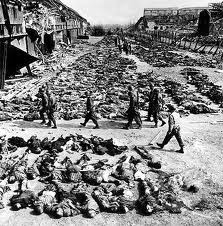
This preventable famine was caused by crop failures in 1942 combined with continued exports of rice from Bengal to other regions of India and elsewhere in the British Empire, the destruction of most of the boats used for transport in the province and the refusal of the government of Winston Churchill to allow emergency food supplies--wheat offered free by the United States and Canada--to be shipped to the starving province.
Governments, including colonial governments, bear responsibility for preventing and mitigating famine. Bengal and Bihar suffered several disastrous famines under British rule--the famine of 1770 took approximately 10 million lives--but few expected that it would happen again under the watch of a liberal, democratic 20th century Britain. Indeed that expectation may be why the immense tragedy of 1943 event is largely overlooked. London turned a bad food shortage into a massive killing famine through its wartime policies. The British had been deliberately keeping food stocks in Bengal low to ensure that if the Japanese conquered Bengal, the occupying forces would not have a ready food supply. The prospect that the Japanese would inherit a starving province no doubt delighted London, and would offer useful propaganda. British soldiers fighting in East Africa and the Middle East were relying on Bengali rice exports, and London thought it expedient and less expensive to feed soldiers with rice than to keep Bengali civilians from starving to death. That they were brown, non-Christian and colonial no doubt had something top do with this calculation. In any event, "Indians did not vote in British elections."
Hence, the government (apparently not having learned from the example of a very similar situation during the Irish Potato Famine) denied an urgent request from Leopold Amery, the Indian secretary of state, and Archibald Wavell, the Viceroy of India, to stop exports of food from Bengal in order that it might be used for famine relief. Winston Churchill, then prime minister, dismissed these requests in a fashion that Amery regarded as "Hitler-like," by asking why, if the famine was so horrible, Gandhi had not yet died of starvation. Indeed, he refused to allow free relief shipments of food from the United States and Canada into Bengal on the grounds that the food was needed more elsewhere. George Orwell echoed Amery's sentiments when he said, "The way the British government is now behaving in India upsets me more than a military defeat."
Embarrassment about this horrific chapter in British history is reflected in academic accounts of economic warfare. Although British historian David Edgerton treats the food issue at length in his otherwise comprehensive 2011 book Britain's War Machine, what happened in Bengal is reduced to one line that combines apology (presumption that it was an accident) and elision (imprecision in the numbers of victims): "Although where the British Army operate abroad there was often shortage as a result, famine was rare, with the great and important exception of the Bengal famine of 1943, when millions died."
The Great Bengal Famine receives little mention in biographies of Winston Churchill; this is in contrast to the Holodomor, which is always mentioned in biographies of Stalin, and the famine in China during the Great Leap Forward, which is always mentioned in biographies of Mao Zedong. This omission perhaps shares similar motivations as denial of the Holocaust by neo-Nazis and denial by communists of the Holodomor and the Chinese mortalities, viz., the biographers are loath to tar the hero of World War II by associating him with such "Hitler-like" nastiness. (Source: http://rationalwiki.org/wiki/Great_Be...)
More:
http://www.ibtimes.com/bengal-famine-...
http://globalavoidablemortality.blogs...
http://www.oxfordscholarship.com/view...
http://www.winstonchurchill.org/learn...
http://en.wikipedia.org/wiki/Bengal_f...
http://suite101.com/a/causes-of-the-g...
http://www.hnn.us/article/129891
(no image)Famine: The Story Of The Great Bengal Famine Of 1943, Of Famines Before And Famines Since, And How Their Threat Can Be Thwarted by Clarence Edward Pike (no photo)
(no image)Bengal Famine of 1943: The American Response by M.S. Venkataramani (no photo)
 by Madhusree Mukerjee (no photo)
by Madhusree Mukerjee (no photo) by Richard Stevenson (no photo)
by Richard Stevenson (no photo) by Rakesh Batabyal (no photo)
by Rakesh Batabyal (no photo) by Henry Bartle Frere (no photo)
by Henry Bartle Frere (no photo) by Peter James Marshall (no photo)
by Peter James Marshall (no photo) by Gopalkrishna Gandhi (no photo)
by Gopalkrishna Gandhi (no photo)
 On of my uncles married a Lady born in India when it was still part of British Empire. I loved her mum. She always used to tell nice and funny stories of her time in India. "When I was in India, you know..." Most of the relatives didn't want to hear those stories anymore. After all, she was nearly 90 yrs and they must have known all her stories for ages. But, me living in Germany, when visiting her in London, I loved those afternoons with her memories of the past.
On of my uncles married a Lady born in India when it was still part of British Empire. I loved her mum. She always used to tell nice and funny stories of her time in India. "When I was in India, you know..." Most of the relatives didn't want to hear those stories anymore. After all, she was nearly 90 yrs and they must have known all her stories for ages. But, me living in Germany, when visiting her in London, I loved those afternoons with her memories of the past.
 The 14th Army in Burma
The 14th Army in Burma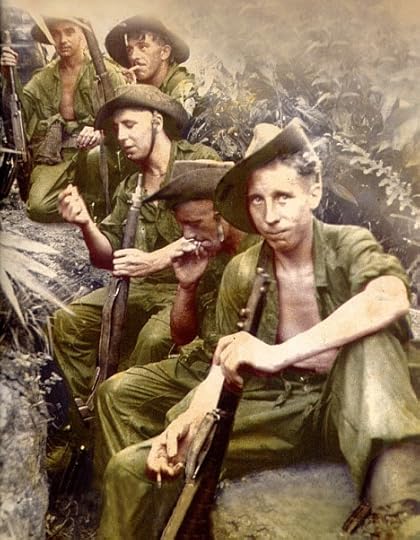
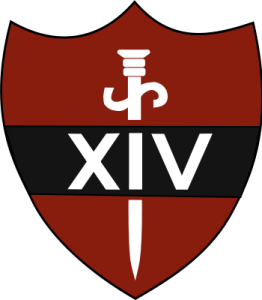
The British Fourteenth Army was a multinational force comprising units from Commonwealth countries during World War II. Many of its units were from the Indian Army as well as British units and there were also significant contributions from West and East African divisions within the British Army.
It was often referred to as the "Forgotten Army" because its operations in the Burma Campaign were overlooked by the contemporary press, and remained more obscure than those of the corresponding formations in Europe for long after the war.
For most of the Army's existence, it was commanded by Lieutenant General William Slim.
The army was formed in 1943 in eastern India. With the creation of South East Asia Command in late 1943, the Eastern Army which formerly controlled operations against the Japanese Army in Burma and also had large rear-area responsibilities, was split into two. Eastern Command (reporting to GHQ India) took over the rear areas of Bihar, Odisha and most of Bengal. Fourteenth Army, part of the British 11th Army Group, became responsible for operations against the Japanese.
In early 1944, the Allies began tentative advances into Burma. The Japanese responded with all-out offensives, intending to destroy the Allies in their base areas. The result of the battles was a crushing Japanese defeat. The Japanese suffered 85,000 casualties, mainly from sickness and disease after their supplies ran out. The Allies had been continually supplied from the air, in the largest operation of its type to that date.
The result of the Battles of Meiktila and Mandalay, known as the Battle of Central Burma, was the destruction of most of the Japanese units in Burma, which allowed the subsequent pursuit.
It was vital to capture Rangoon, the capital and principal port of Burma, to allow the Army to be supplied during the monsoon. In the event, IV Corps was held up 40 miles (64 km) north of Rangoon by sacrificial Japanese rearguards, but its advance caused the Japanese to abandon Rangoon, which was occupied after an unopposed amphibious landing.
The Fourteenth Army was supported by the Women's Auxiliary Service (Burma) who provided a canteen service for the troops of Burma Command and moved down through the country with the Army. (Source: http://en.wikipedia.org/wiki/Fourteen...)
More:
http://www.britishpathe.com/video/the...
http://www.bbc.co.uk/history/ww2peopl...
http://jaskar.hubpages.com/hub/The-fo...
http://www.dailymail.co.uk/news/artic...
http://www.mgtrust.org/burma.
http://www.nationalarchives.gov.uk/ed...
http://www.flickr.com/groups/1665864@...
http://www.mgtrust.org/burma.htm
http://www.youtube.com/watch?v=cFR3qs...
(no image)Senior Leader Decision Making: Lessons Gleaned from Field Marshal Viscount Sir William Slim and Bill Gates by Keith Vore (no photo)
 by David Rooney (no photo)
by David Rooney (no photo) by William Wister Haines (no photo)
by William Wister Haines (no photo) by Michael Hickey (no photo)
by Michael Hickey (no photo) by
by
 William Slim
William Slim by
by
 by William Slim
by William Slim by
by
 James Fenton
James Fenton
 The Chindits
The Chindits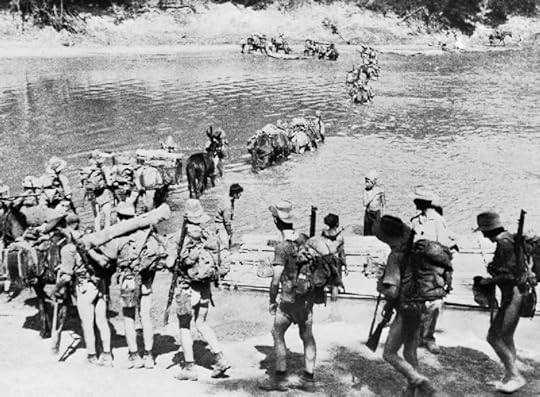

The Chindits were the largest of the allied Special Forces of the 2nd World War. They were formed and lead by Major General Orde Wingate DSO. The Chindits operated deep behind enemy lines in North Burma in the War against Japan. For many months they lived in and fought the enemy in the jungles of Japanese occupied Burma, totally relying on airdrops for their supplies.
There were two Chindits expeditions into Burma, the first in February 1943 Operation Longcloth, consisted of a force of 3,000 men who marched over 1,000 miles during the campaign. The second expedition, Operation Thursday, in March 1944 was on a much larger scale. It was the second largest airborne invasion of the war and consisted of a force of 20,000 British and Commonwealth soldiers with air support provided by the 1st Air Commando USAAF. Tragically their leader, General Wingate, was killed a few weeks after the launch of Operation Thursday.
The Chindits had suffered heavy casualties: 1,396 killed and 2,434 wounded. Over half had to be confined to hospital and prescribed a special nutritional diet whilst hospitalised. As bad as the casualty figures may seem, those suffered by the force in 1943 were proportionally much higher.
The healthy men were sent to training camps to await new operations. However, when the army command evaluated the men and equipment required to return the Chindits to operational status, it was decided to transform the force into an Airborne Division in India. Beyond direct replacements, it was known that the British element of the Chindits would be decimated in 1945 by the need to repatriate personnel who had served more than four years overseas.
During the early months of 1945, several of the brigade headquarters and many of the veterans of the Chindit operations were reformed into the 14th and 77th Infantry Brigades and merged into the 44th Airborne Division (India), while the force headquarters and signals units formed the core of the Indian XXXIV Corps. The Chindits were finally disbanded in February 1945. (Source: http://en.wikipedia.org/wiki/Chindits)
More:
http://www.battleofimphal.com/index.p...
http://thechindit.co.uk/History_of_th...
http://www.chindits.info/
http://www.youtube.com/watch?v=6o1b3B...
http://www.historylearningsite.co.uk/...
http://chindits.wordpress.com/2011/04...
http://www.shotinthedark.info/wp/?p=3...
http://pwencycl.kgbudge.com/C/h/Chind...
(no image)The Chindits And The Stars by Maung Thiha (no photo)
 by Charlton (Jr.) Ogburn (no photo)
by Charlton (Jr.) Ogburn (no photo) by David Rooney (no photo)
by David Rooney (no photo) by David Rooney (no photo)
by David Rooney (no photo) by Philip D. Chinnery (no photo)
by Philip D. Chinnery (no photo) by Tony Redding (no photo)
by Tony Redding (no photo) by Robin Painter (no photo)
by Robin Painter (no photo) by Trevor Royle (no photo)
by Trevor Royle (no photo) by Terence O'Brien (no photo)
by Terence O'Brien (no photo)
 India National Congress
India National Congress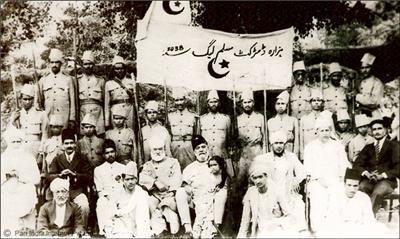
The Congress was founded by Indian and British members of the Theosophical Society movement, most notably A.O. Hume. It has been suggested that the idea was originally conceived in a private meeting of seventeen men after a Theosophical Convention held at Madras in December 1884. Hume took the initiative, and it was in March 1885 that the first notice was issued convening the first Indian National Union to meet at Poona the following December. The objective was obtaining a greater share in government for educated Indians and to form a platform for Indians with the British Raj.
Within a few years, the demands of the INC became more radical in the face of constant opposition from the government, and the party decided to advocate in favour of the independence movement, as it would allow for a new political system in which they could be a majorly dominant party. By 1907 the party was split into two halves—the Garam Dal (literally "hot faction") of Bal Gangadhar Tilak, or Extremists, and the Naram Dal (literally "soft faction") of Gopal Krishna Gokhale, or Moderates—distinguished by their attitude towards the British colonists. Under the influence of Tilak, the Congress became the first organised independence group in the country, bringing together millions of people against the British.
In the pre-independence era, the INC featured a number of prominent political figures: Dadabhai Naoroji and who between 1892 and 1895 was the first Indian Member of Parliament in the British House of Commons. Mohandas Gandhi returned from South Africa in 1915 and with the help of the moderate group led by Ghokhale became president of the Congress,
With the rise of Mahatma Gandhi's popularity and his Satyagraha art of revolution came some powerful politicians. With the already existing nationalistic feeling combined with Gandhi's popularity, the Congress became a forceful and dominant group of people in the country, bringing together millions of people by specifically working against caste differences, untouchability, poverty, and religious and ethnic boundaries. Although predominantly Hindu, it had members from just about every religion, ethnic group, economic class and linguistic group. At the time of the Quit India movement, the Congress was undoubtedly the strongest revolutionary group in India, but the Congress disassociated itself from the Quit India movement within a few days. The Indian National Congress could not claim to be the sole representative of the Indian people as other parties were there as well notably the Hindu Mahasabha, Azad Hind Sarkar, and Forward Bloc.
The 1929 Lahore session under the presidency of Jawaharlal Nehru holds special significance as in this session "Poorna Swaraj" (complete independence) was declared as the goal of the INC. 26 January 1930 was declared as "Poorna Swaraj Diwas", Independence Day, although the British would remain in India for 17 more years. To commemorate this date the Constitution of India was formally adopted on 26 January 1950, even though it had been passed on 26 November 1949.
After the First World War the party became associated with Mohandas K. Gandhi, who remained its unofficial, spiritual leader and mass icon even as younger men and women became party president. The party was in many ways an umbrella organisation, sheltering within itself radical socialists, traditionalists and even Hindu and Muslim conservatives. Members of the Congress initially supported the sailors who led the Royal Indian Navy Mutiny. However they withdrew support at the critical juncture, when the mutiny failed. During the INA trials of 1946, the Congress helped to form the INA Defence Committee, which forcefully defended the case of the soldiers of the Azad Hind government. The committee declared the formation of the Congress' defence team for the INA and included famous lawyers of the time.
The party remained in power for thirty continuous years between independence in 1947 and its first taste of electoral defeat (at the national level) in 1977. (Source: http://en.wikipedia.org/wiki/History_...)
More:
http://www.infoplease.com/encyclopedi...
http://www.historytoday.com/francis-r...
http://www.britannica.com/EBchecked/t...
http://www.fordham.edu/halsall/mod/19...
http://www.thenagain.info/webchron/in...
http://www.open.ac.uk/researchproject...
http://www.indianetzone.com
http://allindiacongress.com/
(no image)All India National Congress by O.P. Ralhan (no photo)
(no image)New India, 1885: British Official Policy and the Emergence of the Indian National Congress by Briton Martin (no photo)
(no image)Evolution Of The Constitutional History Of India, 1773 1947: With Special Reference To The Role Of The Indian National Congress And The Minorities by Vibhuti Bhushan Mishra (no photo)
 by Gyanendra Pandey (no photo)
by Gyanendra Pandey (no photo) by Mike Shepperdson (no photo)
by Mike Shepperdson (no photo) by William Wedderburn (no photo)
by William Wedderburn (no photo) by Gyanendra Pandey (no photo)
by Gyanendra Pandey (no photo)
 Jawaharlal Nehru
Jawaharlal Nehru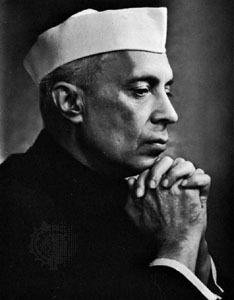
Jawaharlal Nehru was born in Allahabad, the son of a lawyer whose family was originally from Kashmir. He was educated in England, at Harrow School, and then at Trinity College, Cambridge. He studied law at the Inner Temple in London. He returned to India in 1912 and practised law for some years. In 1916, he married Kamala Kaul and the following year they had a daughter, Indira.
In 1919, Nehru joined the Indian National Congress which was fighting for greater autonomy from the British. He was heavily influenced by the organisation's leader Mohandas Gandhi. During the 1920s and 1930s Nehru was repeatedly imprisoned by the British for civil disobedience. In 1928, he was elected president of the Congress.
By the end of World War Two, Nehru was recognised as Gandhi's successor. He played a central role in the negotiations over Indian independence. He opposed the Muslim League's insistence on the division of India on the basis of religion. Louis Mountbatten, the last British viceroy, advocated the division as the fastest and most workable solution and Nehru reluctantly agreed.
On 15 August 1947, Nehru became the first prime minister of independent India. He held the post until his death in 1964. He implemented moderate socialist economic reforms and committed India to a policy of industrialisation.
Nehru also served as foreign minister of India. In October 1947, he faced conflict with Pakistan over the state of Kashmir, which was disputed at independence. Nehru sent troops into the state to support India's claim. A United Nations ceasefire was negotiated, but Kashmir remains deeply unstable to this day.
Against the background of the Cold War, Nehru developed a policy of 'positive neutrality' for India. He became one of the key spokesmen for the non-aligned countries of Africa and Asia, many of which were former colonies that wanted to avoid dependence on any major power.
Despite efforts at cooperation by both countries, Indian-Chinese border disputes escalated into war in 1962 and Indian forces were decisively beaten. This had a significant impact on Nehru's declining health. He died on 27 May 1964.
Two years later Nehru's daughter, Indira Gandhi, became prime minister. With an interruption of only three years, she held the post until her assassination in 1984. Her son Rajiv was prime minister of India from 1984 to 1989, but he too was assassinated. (Source: http://www.bbc.co.uk/history/historic...)
More:
http://en.wikipedia.org/wiki/Jawaharl...
http://en.wikipedia.org/wiki/Nehru%E2...
https://humanism.org.uk/humanism/the-...
http://www-tc.pbs.org/wgbh/commanding...
http://www.reddit.com/r/AskHistorians...
http://gandhifoundation.org/2010/10/2...
http://www.preservearticles.com/20110...
http://www.preservearticles.com/20110...
 by B. Zachariah (no photo)
by B. Zachariah (no photo) by Srinath Raghavan (no photo)
by Srinath Raghavan (no photo) by B.R. Nanda (no photo)
by B.R. Nanda (no photo) by Manorama Mathai (no photo)
by Manorama Mathai (no photo) by
by
 Jawaharlal Nehru
Jawaharlal Nehru by
by
 Shashi Tharoor
Shashi Tharoor by
by
 Stanley Wolpert
Stanley Wolpert by
by
 Tariq Ali
Tariq Ali by
by
 Nayantara Sahgal
Nayantara Sahgal
 Viceroys (Governor Generals) of British India
Viceroys (Governor Generals) of British India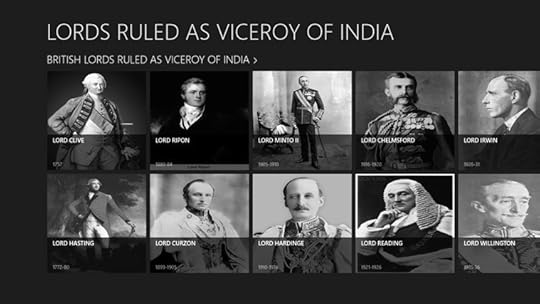
Following the Indian Rebellion of 1857 (usually called the Indian Mutiny by the British), the Government of India Act 1858 made changes in the governance of India at three levels:
a) In the imperial government in London,
b) In the central government in Calcutta, and
c) In the provincial governments in the
presidencies (and later in the provinces).
In London, it provided for a cabinet level Secretary of State for India and a fifteen-member Council of India, whose members were required, as one prerequisite of membership, to have spent at least ten years in India and to have done so no more than ten years before. Although the Secretary of State formulated the policy instructions to be communicated to India, he was required in most instances to consult the Council, but especially so in matters relating to spending of Indian revenues. The Act envisaged a system of "double government" in which the Council ideally served both as a check on excesses in imperial policy making and as a body of up-to-date expertise on India. However, the Secretary of State also had special emergency powers that allowed him to make unilateral decisions, and, in reality, the Council's expertise was sometimes outdated. From 1858 until 1947, twenty seven individuals served as Secretary of State for India and directed the India Office; these included: Sir Charles Wood (1859–1866), Marquess of Salisbury (1874–1878) (later Prime Minister of Britain), John Morley (1905–1910) (initiator of the Minto-Morley Reforms), E. S. Montagu (1917–1922) (an architect of the Montagu-Chelmsford reforms), and Frederick Pethick-Lawrence (1945–1947) (head of the 1946 Cabinet Mission to India). The size of the advisory Council was reduced over the next half-century, but its powers remained unchanged. In 1907, for the first time, two Indians were appointed to the Council. They were K.G. Gupta and Syed Hussain Bilgrami.
In Calcutta, the Governor-General remained head of the Government of India and now was more commonly called the Viceroy on account of his secondary role as the Crown's representative to the nominally sovereign princely states; he was, however, now responsible to the Secretary of State in London and through him to Parliament. A system of "double government" had already been in place during the Company's rule in India from the time of Pitt's India Act of 1784. The Governor-General in the capital, Calcutta, and the Governor in a subordinate presidency (Madras or Bombay) was each required to consult his advisory council; executive orders in Calcutta, for example, were issued in the name of "Governor-General-in-Council" (i.e. the Governor-General with the advice of the Council). The Company's system of "double government" had its critics, since, from the time of the system's inception, there had been intermittent feuding between the Governor-General and his Council; still, the Act of 1858 made no major changes in governance. However, in the years immediately thereafter, which were also the years of post-rebellion reconstruction, Viceroy Lord Canning found the collective decision making of the Council to be too time-consuming for the pressing tasks ahead, so he requested the "portfolio system" of an Executive Council in which the business of each government department (the "portfolio") was assigned to and became the responsibility of a single council member. Routine departmental decisions were made exclusively by the member, but important decisions required the consent of the Governor-General and, in the absence of such consent, required discussion by the entire Executive Council. This innovation in Indian governance was promulgated in the Indian Councils Act 1861.
If the Government of India needed to enact new laws, the Councils Act allowed for a Legislative Council—an expansion of the Executive Council by up to twelve additional members, each appointed to a two-year term—with half the members consisting of British officials of the government (termed official) and allowed to vote, and the other half, comprising Indians and domiciled Britons in India (termed non-official) and serving only in an advisory capacity. All laws enacted by Legislative Councils in India, whether by the Imperial Legislative Council in Calcutta or by the provincial ones in Madras and Bombay, required the final assent of the Secretary of State in London; this prompted Sir Charles Wood, the second Secretary of State, to describe the Government of India as "a despotism controlled from home". Moreover, although the appointment of Indians to the Legislative Council was a response to calls after the 1857 rebellion, most notably by Sir Sayyid Ahmad Khan, for more consultation with Indians, the Indians so appointed were from the landed aristocracy, often chosen for their loyalty, and far from representative. Even so, the "... tiny advances in the practice of representative government were intended to provide safety valves for the expression of public opinion, which had been so badly misjudged before the rebellion". Indian affairs now also came to be more closely examined in the British Parliament and more widely discussed in the British press. (Source: http://en.wikipedia.org/wiki/British_Raj)
More:
http://en.wikipedia.org/wiki/List_of_...
http://en.wikipedia.org/wiki/Governor...
http://palakmathur.wordpress.com/note...
http://www.leadthecompetition.in/GK/h...
http://www.csmantra.com/History/moder...
http://www.historylearningsite.co.uk/...
http://britishempire.co.uk/article/co...
http://thebritishinindia.blogspot.com...
http://www.britishempire.co.uk/maproo...
(no image)The Viceroys Of India by Mark Bence-Jones (no photo)
 by Paul David Nelson (no photo)
by Paul David Nelson (no photo) by Francis Hamilton (no photo)
by Francis Hamilton (no photo) by Source Wikipedia (no photo)
by Source Wikipedia (no photo) by Mohammad Iqbal Chawla (no photo)
by Mohammad Iqbal Chawla (no photo) by Denis Judd (no photo)
by Denis Judd (no photo) by Jesse Russell (no photo)
by Jesse Russell (no photo) by Hugh Tinker (no photo)
by Hugh Tinker (no photo) by Ian McGeoch (no photo)
by Ian McGeoch (no photo)
 Indian Collaboration With The Axis
Indian Collaboration With The Axis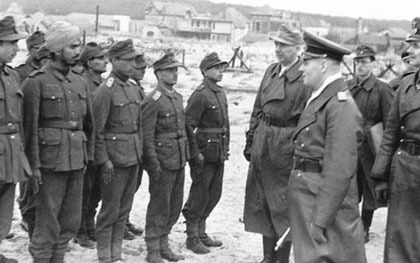
Several leaders of the radical revolutionary Indian independence movement broke away from the main Congress and went to war against Britain. Subhas Chandra Bose, once a prominent leader of Congress, volunteered to help Germany and Japan; he said Britain's opposition to Nazism and Fascism as "hypocrisy" since it was itself violating human rights and denying individual liberties in India. Moreover, he argued that it was not Germany and Japan but the British Raj which was the enemy, since the British were over-exploiting Indian resources for War purposes. Bose suggested that there was little possibility of India being attacked by any of the Axis powers provided it did not fight the War on Britain's side.
Nazi Germany was of the opinion that if the British Raj was dissolved, then India could emerge as a valuable ally of the Axis powers and help it gain dominance in the Indian Ocean area. Berlin was encouraging but gave little help. Tokyo set up an Indian army for Bose.
The Indian National Army (INA), formed first by Mohan Singh Deb consisted initially of prisoners taken by the Japanese in Malaya and at Singapore who were offered the choice of serving the INA by Japan or remaining in very negative conditions in POW camps. Later, after it was reorganized under Subhas Chandra Bose, it drew civilian volunteers from Malaya and Burma. Ultimately, a force of under 40,000 was formed, although only two divisions ever participated in battle. Intelligence and special services groups from the INA were instrumental in destabilizing the British Indian Army in the early stages of the Arakan offensive. It was during this time that the British Military Intelligence began propaganda work to shield the true numbers who joined the INA, and also described stories of Japanese brutalities that indicated INA involvement. Further, the Indian press was prohibited from publishing any accounts whatsoever of the INA.
As the Japanese offensive opened, the INA was sent into battle. Bose hoped to avoid set-piece battles for which it lacked arms, armament as well as man-power. Initially, he sought to obtain arms as well as increase its ranks from British Indian soldiers expected to defect to patriotic cause. Once the Japanese forces were able to break the British defenses at Imphal, he planned for the INA to cross the hills of North-East India into the Gangetic plain, where it was to work as a guerrilla army and expected to live off the land, garner support, supplies, and ranks from amongst the local populace to ultimately touch off a revolution.
As Japan opened its offensive towards India The INA's first division, consisting of four Guerrilla regiments, participated in Arakan offensive in 1944, with one battalion reaching as far as Mowdok in Chittagong. Other units were directed to Imphal and Kohima, as well as to protect Japanese Flanks to the south of Arakan, a task it successfully carried out. However, the first division suffered the same fate as did Mutaguchi's Army when the siege of Imphal was broken. With little or no supplies and supply lines deluged by the Monsoon, harassed by Allied air dominance, the INA began withdrawing when the 15th Army and Burma Area Army began withdrawing, and suffer the same terrible fate as wounded, starved and diseased men succumbed during the hasty withdrawal into Burma. Later in the war however, the INA's second division, tasked with the defence of Irrawaddy and the adjoining areas around Nangyu, was instrumental in opposing Messervy's 7th Indian Infantry Division when it attempted to cross the river at Pagan and Nyangyu during the successful Burma Campaign by the Allies the following year. The 2nd division was instrumental in denying the 17th Indian Infantry Division the area around Mount Popa that would have exposed the Flank of Kimura's forces attempting to retake Meiktila and Nyangyu. Ultimately however, the division was obliterated. Some of the surviving units of the Army surrendered as Rangoon fell, and helped keep order till the allied forces entered the city. The other remnants began a long march over land and on foot towards Singapore, along with Subhas Chandra Bose. As the Japanese situation became precarious, Bose left for Manchuria to attempt to contact the Russians, and was reported to have died in an air crash near Taiwan.
The only Indian territory that the Azad Hind government controlled was nominally the Andaman and Nicobar Islands. However, they were bases for the Japanese Navy, and the navy never relinquished control. Enraged with the lack of administrative control, the Azad Hind Governor, Lt. Col. Loganathan, later relinquished his authority. After the War, a number of officers of the INA were tried for treason. However, faced with the possibility of a massive civil unrest and a mutiny in the Indian Army, the British officials decided to release the prisoners-of-war, in addition the event became a turning point to expedite the process of transformation of power & India's independence. (Source: http://en.wikipedia.org/wiki/India_in...)
More:
http://www.studymode.com/essays/The-I...
http://www.ihr.org/jhr/v03/v03p407_Bo...
http://www.bbc.co.uk/history/ww2peopl...
http://ww2talk.com/forums/topic/5104-...
http://desertwar.net/indian-national-...
http://stamporama.com/articles/displa...
http://2ndlook.wordpress.com/tag/indi...
http://indiansaga.com/history/ina_tri...
 by Gurubkshasirmh Dhilorm (no photo)
by Gurubkshasirmh Dhilorm (no photo) by Hugh Toye (no photo)
by Hugh Toye (no photo) by Romain Hayes (no photo)
by Romain Hayes (no photo) by Nilanjana Sengupta (no photo)
by Nilanjana Sengupta (no photo) by Marshall J. Getz (no photo)
by Marshall J. Getz (no photo) by Jesse Russell (no photo)
by Jesse Russell (no photo) by Joyce Chapman Lebra (no photo)
by Joyce Chapman Lebra (no photo) by
by
 Anant Pai
Anant Pai by
by
 Sugata Bose
Sugata Bose
 The White Man's Burden
The White Man's Burden
The poem,The White Man's Burden" was written by Rudyard Kipling and was originally dedicated to the American war in the Philippines but it soon was adopted by the British as the hymn to colonialism and the Raj in India. Historians have many views as to exactly what the term "the white man's burden" means.
One view proposes that white people have an obligation to rule over, and encourage the cultural development of people from other cultural backgrounds until they can take their place in the world economically and socially. The term "the white man's burden" has been interpreted by some as racist, or possibly taken as a metaphor for a condescending view of undeveloped national culture and economic traditions, identified as a sense of European ascendancy which has been called "cultural imperialism". An alternative interpretation is the philanthropic view, common in Kipling's formative years, that the rich (whites) have a moral duty and obligation to help "the poor" (coloreds) "better" themselves whether the poor (coloreds) want the help or not.
On the face of it, the poem conveys a positive view of the idea that "The White Man", generally accepted to mean the colonial powers (Great Britain, France, Spain, Portugal, Holland, Denmark, Germany, Russia, Italy and the United States), had a duty to civilize the more brutish and barbaric parts of the world. It begins by describing the colonized Filipinos as "new-caught, sullen peoples, half devil and half child". Although a belief in the virtues of empire was widespread at the time, there were also many dissenters; the publication of the poem caused a flurry of arguments from both sides, most notably from Mark Twain and Henry James. While Kipling may have intended the piece as a form of satire, much of Kipling's other writing does suggest that he genuinely believed in the "beneficent role" which the introduction of Western ideas could play in lifting non-Western peoples out of poverty and ignorance.Lines 3–5, and other parts of the poem suggest that it is not just the native people who are held in captivity, but also the "functionaries of empire", who are caught in colonial service and may die while helping other races less fortunate than themselves (hence "burden").
An analysis focused on the social status and background of colonial officers active at the time is lacking; as is one of the Christian missionary movement, also quite active at the time in parts of the world under colonial rule (e.g. the Christian and Missionary Alliance) which also emphasised the theme of aiding those less fortunate. Several authors note that Kipling offered the poem to Theodore Roosevelt to help persuade many doubting Americans to seize the Philippines. His work with regards to British colonialism in India had become widely popular in the United States. The poem could be viewed as a way for Kipling to share the virtues of British colonialism with Americans. In September 1898 Kipling wrote to Roosevelt, stating 'Now go in and put all the weight of your influence into hanging on permanently to the whole Philippines. America has gone and stuck a pickaxe into the foundations of a rotten house and she is morally bound to build the house over again from the foundations or have it fall about her ears'. He forwarded the poem to Roosevelt in November of the same year, just after Roosevelt was elected Governor of New York.
The Norton Anthology of English Literature argues the poem is in line with Kipling's strong imperialism and a belief of a "Divine Burden to reign God's Empire on Earth." According to Steve Sailer, however, writer John Derbyshire has described Kipling as "an imperialist utterly without illusions about what being an imperialist actually means. Which, in some ways, means that he was not really an imperialist at all." (Source: http://en.wikipedia.org/wiki/The_Whit...)
More:
http://www.fordham.edu/halsall/mod/ki...
http://world-history.nmhblogs.org/201...
http://www.victorianweb.org/authors/k...
http://library.thinkquest.org/C004367...
http://www.gradesaver.com/rudyard-kip...
http://wiki.answers.com/Q/What_is_the...
http://www.huffingtonpost.co.uk/abhae...
http://www.poetryfoundation.org/bio/r...
(no image)Sahibs India: Vignettes Of The Raj by Pran Nevile (no photo)
(no image)The White Sahibs in India by Reginald Arthur Reynolds (no photo)
(no image)The Sahibs: The Life and Ways of the British in India as Recorded By Themselves by Hilton Brown (no photo)
(no image)The White Man's Burden by
 Paul Theroux
Paul Theroux by David Gilmour (no photo)
by David Gilmour (no photo) by Harry Ricketts (no photo)
by Harry Ricketts (no photo) by Chris Brooks (no photo)
by Chris Brooks (no photo) by
by
 William Easterly
William Easterly by
by
 B.F. Riley
B.F. Riley by
by
 Kingsley Amis
Kingsley Amis by
by
 Charles Allen
Charles Allen
 The Gurkhas
The Gurkhas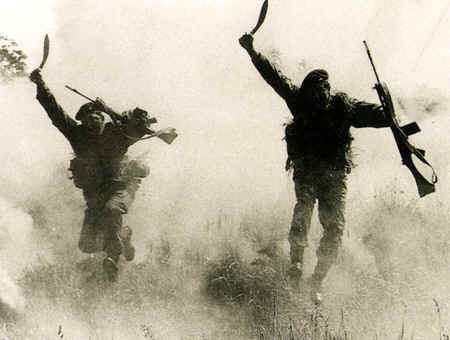
The Gurkhas are indigenous people mainly from the mid-western and eastern Nepal. Their name derives from the Hindu warrior-saint Guru Gorakhnath (8th century ).
There are Gurkha military units in the Nepalese, British and the Indian army (Gurkhas) enlisted in Nepal. Although they meet many of the requirements of Article 47 of Protocol I of the Geneva Conventions regarding mercenaries, they are exempt under clauses 47(a)(c)(d)(e)&(f) similar to the French Foreign Legion.
Gurkhas are closely associated with the khukuri, a forward-curving Nepalese knife and have a well known reputation for their fearless military prowess. The former Indian Army Chief of Staff Field Marshal Sam Manekshaw, once stated that "If a man says he is not afraid of dying, he is either lying or is a Gurkha."
From the end of the Indian Rebellion of 1857 until the start of World War I the Gurkha Regiments saw active service in Burma, Afghanistan, the North-East Frontier and the North-West Frontiers of India, Malta (the Russo-Turkish War, 1877–78), Cyprus, Malaya, China (the Boxer Rebellion of 1900) and Tibet (Younghusband's Expedition of 1905).
Between 1901 and 1906, the Gurkha regiments were renumbered from the 1st to the 10th and re-designated as the Gurkha Rifles. In this time, the Brigade of Gurkhas, as the regiments came to be collectively known, was expanded to twenty battalions within the ten regiments.
During World War I (1914–18), more than 200,000 Gurkhas served in the British Army, suffering approximately 20,000 casualties, and receiving almost 2,000 gallantry awards. The number of Gurkha battalions was increased to thirty-three, and Gurkha units were placed at the disposal of the British high command by the Nepalese government for service on all fronts. Many Nepalese volunteers served in non-combatant roles, serving in units such as the Army Bearer Corps and the labour battalions, but there were also large numbers that served in combat in France, Turkey, Palestine, and Mesopotamia. They served on the battlefields of France in the Loos, Givenchy, Neuve Chapelle and Ypres; in Mesopotamia, Persia, Suez Canal and Palestine against Turkish advance, Gallipoli and Salonika. One detachment served with Lawrence of Arabia, while during the Battle of Loos (June–December 1915) a battalion of the 8th Gurkhas fought to the last man, hurling themselves time after time against the weight of the German defences, and in the words of the Indian Corps commander, Lieutenant-General Sir James Willcocks, "... found its Valhalla". During the ultimately unsuccessful Gallipoli campaign in 1915, the Gurkhas were among the first to arrive and the last to leave. The 1st/6th Gurkhas, having landed at Cape Helles, led the assault during the first major operation to take out a Turkish high point, and in doing so captured a feature that later became known as "Gurkha Bluff". At Sari Bair they were the only troops in the whole campaign to reach and hold the crest line and look down on the Straits, which was the ultimate objective. The 2nd Battalion of the 3rd Gurkha Rifles (2nd/3rd Gurkha Rifles) was involved in the conquest of Baghdad.
Following the end of the war, the Gurkhas were returned to India and during the inter-war years, they were largely kept away from the internal strife and urban conflicts of the sub-continent, instead being employed largely on the frontiers and in the hills where fiercely independent tribesmen were a constant source of troubles.
During World War II (1939–45), there were ten Gurkha regiments, with two battalions each making a total of twenty pre-war battalions. Following the Dunkirk evacuation of the British Expeditionary Force in 1940, the Nepalese government offered to increase recruitment to increase the total number of Gurkha battalions in British service to thirty-five. This would eventually rise to forty-three battalions and in order to achieve this, third and fourth battalions were raised for all ten regiments, with fifth battalions also being raised for 1 GR, 2 GR and 9 GR. This expansion required ten training centres to be established for basic training and regimental records across India. In addition five training battalions were raised, while other units were raised as garrison battalions for keeping the peace in India and defending rear areas. Large numbers of Gurkha men were also recruited for non-Gurkha units, and other specialised functions such as paratroops, signals, engineers, and military police.
A total of 250,280 Gurkhas served in 40 battalions, plus eight Nepalese Army battalions, plus Parachute, training, garrison, and porter units during the war, in almost all theatres. In addition to keeping peace in Nepal, Gurkhas fought in Syria, North Africa, Italy, Greece and against the Japanese in the jungles of Burma, northeast India and also Singapore. They did so with considerable distinction, earning 2,734 bravery awards in the process and suffering around 32,000 casualties in all theatres. (Source: http://en.wikipedia.org/wiki/Gurkha)
More:
http://14usaaf27tcs.4mg.com/gurkhas.html
http://deadliestwarrior.wikia.com/wik...
http://www.ayo-gorkhali.org/index.php...
http://www.himalayan-imports.com/gurk...
http://www.independent.co.uk/news/uk/...
http://www.khukurihouseonline.com/Con...
http://www.spike.com/shows/deadliest-...
http://www.spiritofremembrance.com/pa...
 by Byron Farwell (no photo)
by Byron Farwell (no photo) by Mike Chappell (no photo)
by Mike Chappell (no photo) by John Parker (no photo)
by John Parker (no photo) by Tony Gould (no photo)
by Tony Gould (no photo) by Lionel Caplan (no photo)
by Lionel Caplan (no photo) by Tim Penyusun Edisi Koleksi Angkasa (no photo)
by Tim Penyusun Edisi Koleksi Angkasa (no photo) by E.D. Smith (no photo)
by E.D. Smith (no photo) by J.B.R. Nicholson (no photo)
by J.B.R. Nicholson (no photo) by H.E. Weeks (no photo)
by H.E. Weeks (no photo) by John Walter (no photo)
by John Walter (no photo)
 Hinduism
Hinduism
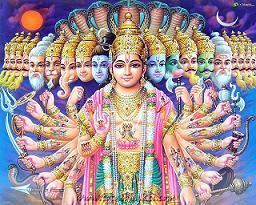
Hinduism is the dominant religion of the Indian subcontinent, particularly of India and Nepal. It includes Shaivism, Vaishnavism, Smartism among numerous other traditions. Among other practices and philosophies, Hinduism includes a wide spectrum of laws and prescriptions of "daily morality" based on karma, dharma, and societal norms. Hinduism is a categorisation of distinct intellectual or philosophical points of view, rather than a rigid, common set of beliefs.
Hinduism consists of many diverse traditions and has no single founder. Among its direct roots is the historical Vedic religion of Iron Age India. As such, Hinduism is often called the "oldest living religion" or the "oldest living major religion" in the world. Since Vedic times, a process of Sanskritization has been taking place, in which "people from many strata of society throughout the subcontinent tended to adapt their religious and social life to Brahmanic norms".
Hindu texts are classified into Śruti ("revealed") and Smriti ("remembered"). These texts discuss theology, philosophy, mythology, Vedic yajna and agamic rituals and temple building, among other topics. Major scriptures include the Vedas, Upanishads, Puranas, Mahabharata, Ramayana, Manusmriti, Bhagavad Gita and Agamas.
Hindu practices generally involve seeking awareness of God and sometimes also seeking blessings from Devas. Therefore, Hinduism has developed numerous practices meant to help one think of divinity in the midst of everyday life. Hindus can engage in puja (worship or veneration),either at home or at a temple. At home, Hindus often create a shrine with icons dedicated to their chosen form of God. Temples are usually dedicated to a primary deity along with associated subordinate deities though some commemorate multiple deities. Visiting temples is not obligatory, and many visit temples only during religious festivals. Hindus perform their worship through icons (murtis). The icon serves as a tangible link between the worshiper and God. The image is often considered a manifestation of God, since God is immanent. The Padma Purana states that the mūrti is not to be thought of as mere stone or wood but as a manifest form of the Divinity. A few Hindu sects, such as the Ārya Samāj, do not believe in worshiping God through icons.
Mantras are invocations, praise and prayers that through their meaning, sound, and chanting style help a devotee focus the mind on holy thoughts or express devotion to God/the deities. Many devotees perform morning ablutions at the bank of a sacred river while chanting the Gayatri Mantra or Mahamrityunjaya mantras. The epic Mahabharata extols Japa (ritualistic chanting) as the greatest duty in the Kali Yuga (what Hindus believe to be the current age). Many adopt Japa as their primary spiritual practice. Yoga is a Hindu discipline which trains the consciousness for tranquility, health and spiritual insight. This is done through a system of postures and exercises to practice control of the body and mind.
Hinduism, with about one billion followers (950 million estimated in India), is the world's third largest religion, after Christianity and Islam. (Source: http://en.wikipedia.org/wiki/Hinduism)
More:
http://www.bbc.co.uk/religion/religio...
http://www.himalayanacademy.com/readl...
http://www.patheos.com/Library/Hindui...
http://www.religionfacts.com/hinduism...
http://hinduism.about.com/
http://www.socialstudies.com/c/articl...
http://www.probe.org/site/c.fdKEIMNsE...
 by Kshiti Mohan Sen (no photo)
by Kshiti Mohan Sen (no photo) by Louis Renou (no photo)
by Louis Renou (no photo) by Gavin D. Flood (no photo)
by Gavin D. Flood (no photo) by Anonymous (no photo)
by Anonymous (no photo) by
by
 Huston Smith
Huston Smith by
by
 Paramahansa Yogananda
Paramahansa Yogananda by
by
 Ram Dass
Ram Dass
 Partition (The Mountbatten Plan)
Partition (The Mountbatten Plan)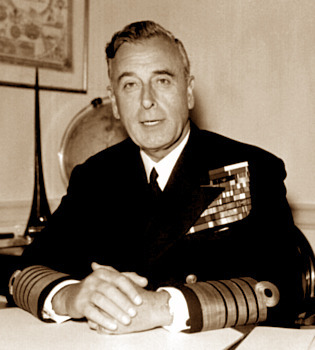
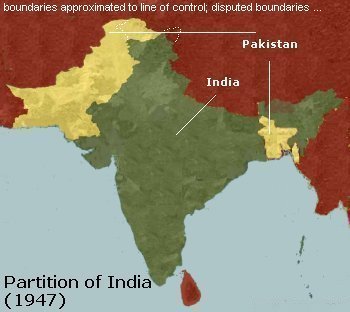
The Indian Independence Act 1947 was as an Act of the Parliament of the United Kingdom that partitioned British India into the two new independent dominions of India and Pakistan. The Act received the royal assent on 18 July 1947, and Pakistan came into being on August 14, and India on August 15, as two new countries.
The legislation was formulated by the government of Prime Minister Clement Attlee, after representatives of the Indian National Congress, the Muslim League, and the Sikh community came to an agreement with the Viceroy of India, Lord Mountbatten of Burma, on what has come to be known as the 3 June Plan or Mountbatten Plan.
The Prime Minister of the United Kingdom, Clement Attlee, announced on 20 February 1947 that:
a) British Government would grant full self-government to British India by June 1948 at the latest,
b) The future of Princely States would be decided after the date of final transfer is decided.
This was also known as the Mountbatten Plan. The British government proposed a plan announced on 3 June 1947 that included these principles:
a) Principle of Partition of India was accepted by the British Government
b) Successor governments would be given dominion status
c) Implicit right to secede from the British Commonwealth
The Indian Independence Act 1947 was the implementation of the Mountbatten Plan and the Act's most important provisions were:
a) the division of British India into the two new and fully sovereign dominions of India and Pakistan, with effect from 15 August 1947;
b) the partition of the provinces of Bengal and Punjab between the two new countries;
c) the establishment of the office of Governor-General in each of the two new countries, as representative of the Crown;
d) the conferral of complete legislative authority upon the respective Constituent Assemblies of the two new countries;
e) the termination of British suzerainty over the princely states, with effect from 15 August 1947, and recognized the right of states to accede to either dominion;
f) the dropping of the use of the title "Emperor of India" by the British monarch (this was subsequently done by King George VI by royal proclamation on 22 June 1948).
The Act also made provision for the division of joint property, etc. between the two new countries, including in particular the division of the armed forces. (Source: http://en.wikipedia.org/wiki/Indian_I...)
More:
http://encyclopedia2.thefreedictionar...
http://www.preservearticles.com/20110...
http://www.indianexpress.com/news/-mo...
http://dilipchandra12.hubpages.com/hu...
http://www.shareyouressays.com/89946/...
http://www.indhistory.com/partition-p...
http://www.meritnation.com/ask-answer...
http://storyofpakistan.com/june-3rd-p...
http://www.boloji.com/index.cfm?md=Co...
 by Rabia Umar Ali (no photo)
by Rabia Umar Ali (no photo) by Jaswant Singh (no photo)
by Jaswant Singh (no photo) by Yasmin Khan (no photo)
by Yasmin Khan (no photo) by David Page (no photo)
by David Page (no photo) by Joya Chatterji (no photo)
by Joya Chatterji (no photo) by Rituparna Roy (no photo)
by Rituparna Roy (no photo) by Mohammed Yunus (no photo)
by Mohammed Yunus (no photo) by Jeff Hay (no photo)
by Jeff Hay (no photo) by Narendra Singh Sarila (no photo)
by Narendra Singh Sarila (no photo) by Neeti Nair (no photo)
by Neeti Nair (no photo) by Ayesha Jalal (no photo)
by Ayesha Jalal (no photo) by
by
 Urvashi Butalia
Urvashi Butalia
 Suttee (Sati)
Suttee (Sati)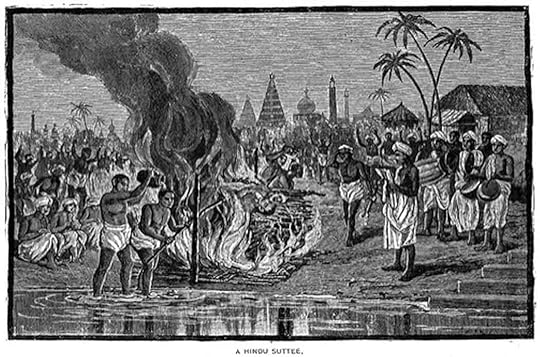
Suttee (or sati) is the Indian custom of a widow burning herself, either on the funeral pyre of her dead husband or in some other fashion, soon after his death. Although never widely practiced, suttee was the ideal of certain Brahman and royal castes. It is sometimes linked to the myth of the Hindu goddess Sati, who burned herself to death in a fire that she created through her yogic powers after her father insulted her husband, the god Shiva—but in this myth Shiva remains alive and avenges Sati’s death.
The first explicit reference to the practice in Sanskrit appears in the great epic Mahabharata (compiled in its present form in 400 ce). It is also mentioned by Diodorus Siculus, a Greek author of the 1st century bce, in his account of the Punjab in the 4th century bce. Numerous suttee stones, memorials to the widows who died in this way, are found all over India, the earliest dated 510 ce. Women sometimes suffered immolation before their husbands’ expected death in battle, in which case the burning was called jauhar. In the Muslim period (12th–16th century), the Rajputs practiced jauhar, most notably at Chitorgarh, to save women from rape, which they considered worse than death, at the hands of conquering enemies. During the medieval period, which began in the 8th century, the hardships encountered by widows in traditional Hindu society may have contributed to its spread.
The larger incidence of suttee among the Brahmans of Bengal was indirectly due to the Dayabhaga system of law (c. 1100), which prevailed in Bengal and which gave inheritance to widows. In the 16th century, steps to prohibit suttee were taken by the Mughal rulers Humayun and his son Akbar. Suttee became a central issue under the British Raj, which first tolerated it, then inadvertently legalized it by legislating conditions under which it could be done, and then finally, in 1829, outlawed it—using the condemnation as one of its justifications for continuing British rule of India.
Suttee was sometimes committed voluntarily, but cases of compulsion, escape, and rescue are known. Scattered instances of it continue to occur, most notoriously in the case of Roop Kanwar, an 18-year-old widow who committed suttee in 1987. The incident was highly controversial, as groups throughout India either publicly defended Kanwar’s actions or declared that she had been murdered. (Source: http://www.britannica.com/EBchecked/t...)
More:
http://en.wikipedia.org/wiki/Sati_%28...
http://www.historyextra.com/oup/sutte...
http://www.poetryloverspage.com/poets...
http://www.theguardian.com/world/2002...
http://www.ibiblio.org/britishraj/Jac...
http://www.fordham.edu/halsall/mod/18...
http://onlinelibrary.wiley.com/doi/10...
http://chnm.gmu.edu/wwh/modules/lesso...
http://www.csuchico.edu/~cheinz/sylla...
 by Sakuntal Narasimhan (no photo)
by Sakuntal Narasimhan (no photo) by Mala Sen (no photo)
by Mala Sen (no photo) by John Stratton Hawley (no photo)
by John Stratton Hawley (no photo) by Andrea Major (no photo)
by Andrea Major (no photo) by Hephaestus Books (no photo)
by Hephaestus Books (no photo) by Lata Mani (no photo)
by Lata Mani (no photo) by
by
 Anant Pai
Anant Pai
 Indian Caste System
Indian Caste System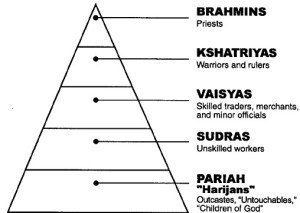
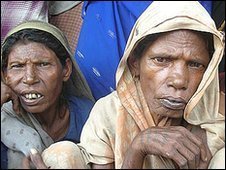
The caste system in India can be described as an elaborately stratified social hierarchy distinguishing India’s social structure from any other nation. Its history is multifaceted and complex.
Caste is a term, which is used to specify a group of people having a specific social rank and dates back to 1200 BCE. The Indian term for caste is jati, and generally designates a group that can vary in size from a handful to many thousands. There are thousands of jatis each with its own rules and customs. The various jatis are traditionally arranged in hierarchical order and fit into one of the four basic varnas the (Sanskrit word for “colors”).
--The varna of Brahmans, commonly identified with priests and the learned class
--The varna of Kshatriyas, associated with rulers and warriors including property owners.
--The varna of Vaishyas, associated with commercial livelihoods (i.e. traders)
--The varna of Shudras, the servile laborers
The Untouchables occupy a place that is not clearly defined by boundaries and is outside of the varna scheme. Their jobs (such as toilet cleaning and garbage removal) cause them to be considered impure and thus “untouchable.” Historically the untouchables were not allowed in temples and many other public places. In 1950 legislation was passed to prevent any form of discrimination towards the untouchables. Although legislation has affected the status of the people, they are yet very much a visible part of Indian society.
Religious Background
The earliest expressions of caste can be found in one of India’s vast bodies of religious scripture known as the Vedas, which are though to have been complied between 1500 and 1000 BCE, although the time of their composition is under debate. They were transmitted orally for many generations before being written down. Therefore, centuries may have passed before they were ever committed to writing.
These works are considered the source of ancient Indian wisdom. The first of the four basic Vedic books is the Rig Veda; a collection of over 1,000 hymns containing the basic mythology of the Aryan gods. The Rig Veda contains one of the most famous sections in ancient Indian literature in which the first man created, Purusa, is sacrificed in order to give rise to the four varnas. The Brahmin was his mouth, his two arms were made the Rajanya [Kshatriya, king and warrior], his two thighs [loins] the Vaishya, from
his feet the Sudra [servile class] was born.
It can be argued that the composers of the Vedas, especially those sections within the Vedas called the Brahmanas, were concerned with the interconnections that organized reality . This way of looking at the varnas allows us to see how such a system can survive several millennia. It classifies people not only in terms of their different qualities but also with respect to their different privileges. Each class thus has a special role to play in society as well as a unique function: this structure is a means of creating and organizing an effective society.
The varna system is inter-linked with creation, lending itself a great deal of reverence and validity.
If space, time the congregation of the gods and goddesses, the natural world, scripture and ritual, and the human body itself- if all these realms bear classification according to varna, how could an organization of society be regarded as anything other than the way things should be?
An important thing to note is that the Vedas do NOT mention a concept such as Untouchability. It is a part of the system that has been created by society itself.
Society Pre-Colonialism
Although the nation has a long and varied history, the role of the caste system pre-colonialism can be understood by focusing on the major eras in Indian history. Much of India is rural and that which is not, for the most part, is much more urban. with such a drastic difference in the city and the village there is also a difference in the way caste has been interpreted and implemented over the years.
The early system most represented something analagous to the mideval guild system. It allowed a specialization of society and each member knew their role. Much later in India's history, as India became more and more prevalent in the international scene the concept of the caste system began to have different connotations. It was thought of as backward by much of the west. The greatest changes in the perception as well as in the reality came with the coming and going of the British. (Source: http://www.mtholyoke.edu/~epandit/pag...)
More:
http://www.mrdowling.com/612-caste.html
http://en.wikipedia.org/wiki/Caste_sy...
http://asiasociety.org/countries/trad...
http://www.dummies.com/how-to/content...
http://www.britishempire.co.uk/articl...
http://www.victorianweb.org/history/e...
http://www.shareyouressays.com/87481/...
http://www.economist.com/blogs/erasmu...
(no image)Social Mobility in the Caste System in India: An Interdisciplinary Symposium by James Silverberg (no photo)
 by Brian K. Smith (no photo)
by Brian K. Smith (no photo) by Human Rights Watch Asia (no photo)
by Human Rights Watch Asia (no photo) by Hiroyuki Kotani (no photo)
by Hiroyuki Kotani (no photo) by Shakuntala Devi (no photo)
by Shakuntala Devi (no photo) by Exta Singh
by Exta Singh by Source Wikipedia (no photo)
by Source Wikipedia (no photo) by Narendra Jadhav (no photo)
by Narendra Jadhav (no photo)
 Indians in England (Population and Discrimination)
Indians in England (Population and Discrimination)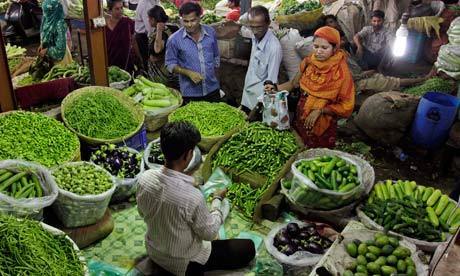

The term British Indian (also Indian British or Indian Britons) refers to citizens of the United Kingdom whose ancestral roots lie in India. This includes people born in the UK who are of Indian descent, and Indian-born people who have migrated to the UK. Today, Indians comprise about 1.4 million people in the UK (not including those of mixed Indian and other ancestry), making them the single largest visible ethnic minority population in the country. They make up the largest subgroup of British Asians, and are one of the largest Indian communities in the Indian diaspora, mainly due to the Indian-British relations (including historical links such as India having been under British colonial occupation and still being part of the Commonwealth of Nations). The British Indian community is the fifth largest in the Indian diaspora, behind the Indian communities in Nepal, the United States, Malaysia and Burma.
British Indians are socioeconomically affluent and are primarily members of the middle class. A study by the Joseph Rowntree Foundation in 2011 found British Indians have among the lowest poverty rates among all ethnic groups in Britain, second only to White British.
Following the Second World War and the breakup of the British Empire, Indian migration to the UK increased through the 1950s and 1960s. The Commonwealth Immigrants Act 1962 and Immigration Act 1971 largely restricted any further primary immigration, although family members of already-settled migrants were still allowed. In addition, much of the subsequent growth in the British Indian community has come from the births of second- and third-generation Indian Britons.
Although post-war immigration was continuous, several distinct phases can be identified:
a) Workers were recruited to fulfill the labour shortage that resulted from World War II. These included Anglo-Indians who were recruited to work on the railways as they had done in India.
b) Workers mainly from the Punjab region arrived in the late 1950s and 1960s. Many worked in the foundries of the English Midlands and a large number of Sikh people worked at Heathrow Airport in west London. This created an environment to where the next generation of families do not lose their identity as easily.
c) During the same time, medical staff from India were recruited for the newly formed National Health Service. These people were targeted as the British had established medical schools in the Indian subcontinent which conformed to the British standards of medical training.
d) During the 1960s and 1970s, large numbers of East African Indians, who already held British passports, entered the UK after they were expelled from Kenya, Uganda and Zanzibar. Many of these people had been store-keepers in Africa and opened shops when they arrived in the UK.
Discrimination against persons of Indian origin in the United Kingdom is not completely widespread, but has been known to happen in certain instances. The names and racial slurs given to British Indians by some members the white community are evidence of lack of knowledge and ignorance, the pejorative "Paki" is likely to be the most commonly used anti-Asian slur in the UK and despite it being a back-formation and derogatory term used to refer to a person of Pakistani origin it is all too often used to refer to anyone from the Indian subcontinent. However, some young British Pakistanis have attempted to reclaim the word and use it in a non-offensive way to refer to themselves.
Tamils protesting against the Sri Lankan Civil War outside of India House
Verbal discrimination has become somewhat more common after the 9/11 and 7/7 attacks,[citation needed] even though Islam extremists who committed these atrocities have little to do with the British Indian community. A notable example of anti-Indian sentiment in the UK is the 2007 Celebrity Big Brother racism controversy which received significant media coverage. White contestants Jade Goody (who is mixed race), Danielle Lloyd and Jo O'Meara were all seen to have been mocking Bollywood actress Shilpa Shetty because of her accent. They also persisted in making fun of general parts of Indian culture. Channel 4 screened the arguments between the contestants, which received over 50,000 complaints. The controversy generated over 300 newspaper articles in Britain, 1,200 in English language newspapers around the globe, 3,900 foreign language news articles, and 22,000 blog postings on the internet.
Another example of discrimination is the Expulsion of Asians in Uganda in 1972 (a decision made by the President of Uganda to ethnically cleanse the country) which lead to tens of thousands of East African Indians coming to the UK to start a new life, the majority of these already had British passports, due to Uganda at that time being part of the British Empire.
Other examples of discrimination towards British Indians in the mainstream population include the case of 27 year old Chetankumar Meshram, a call centre trainer from Northampton who was compensated £5,000 after his boss told him he was to be replaced by a better English speaker. Also Meena Sagoo, 42 is demanding over £100,000 after herself and a fellow employee of the ING Bank of Sri Lankan heritage were called The Kumars at No. 42 (after the popular TV comedy show of the same name). The same bank has been noted to have paid out £20,000 to a worker of Chinese origin who also claimed racial harassment.
Another form of discrimination towards British Indians is stereotyping, one example is British Asians stereotyped as being the majority of newsagent and convenience store shopkeepers, the stereotype "Paki shop"; and also making up a majority of doctors. These are all often associated as being hardworking. This stereotype was often made fun of in television and radio sketches. (Source: http://en.wikipedia.org/wiki/British_...)
More:
http://en.wikipedia.org/wiki/Indian_c...
http://www.dailymail.co.uk/news/artic...
http://www.telegraph.co.uk/news/uknew...
ndiatoday.intoday.in/story/indians-to...
http://ibnlive.in.com/news/most-india...
http://articles.timesofindia.indiatim...
http://topnews.co.uk/28948-population...
http://www.jnu.ac.in/library/IMDS_Wor...
(no image)Ayahs, Lascars and Princes: Indians in Britain 1700-1947 by Rozina Visram (no photo)
(no image)India In Britain: The Indian Contribution To The British Way Of Life by Kusoom Vadgama (no photo)
(no image)Indians In Britain by Rozina Visram (no photo)
 by Shompa Lahiri (no photo)
by Shompa Lahiri (no photo) by A. Martin Wainwright (no photo)
by A. Martin Wainwright (no photo) by Frank Anthony (no photo)
by Frank Anthony (no photo) by C.A. Bayly (no photo)
by C.A. Bayly (no photo) by Books LLC (no photo)
by Books LLC (no photo) by Maritsa Poros (no photo)
by Maritsa Poros (no photo) by
by
 Emma Jolly
Emma Jolly
 The Indian Army in World War II
The Indian Army in World War II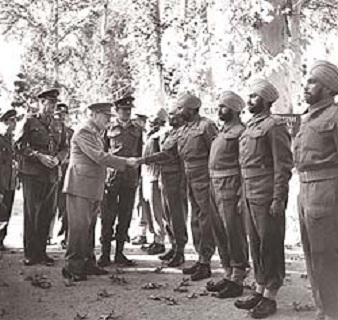
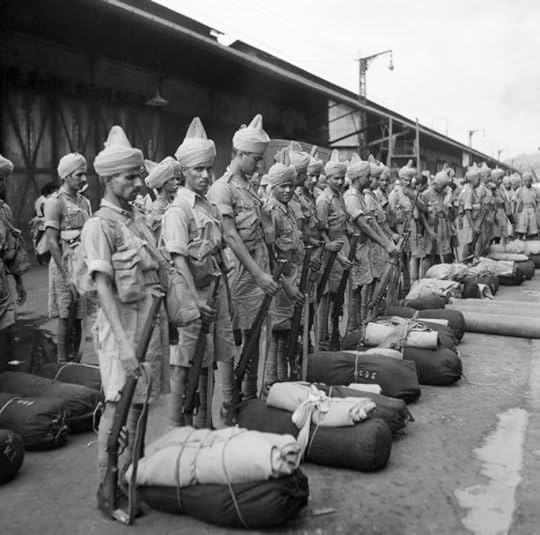
In 1939 the Indian Army numbered 205,000 men. It took in volunteers and by 1945 was the largest all-volunteer force in history, rising to over 2.5 million men. These forces included tank, artillery and airborne forces. Indian soldiers earned 30 Victoria Crosses during the World War II.
The British government sent Indian troops to fight in West Asia and northern Africa against the Axis. India also geared up to produce essential goods such as food and uniforms. Pre-Independence India provided the largest volunteer force (2.5 million) of any nation during World War II.
The 4th, 5th and 10th Indian Divisions took part in the North African theatre against Rommel's Afrika Korps.In addition, the 18th Brigade of the 8th Indian Division fought at Alamein. Earlier, the 4th and 5th Indian Divisions took part in the East African campaign against the Italians in Somaliland, Eritrea and Abyssinia capturing the mountain fortress of Keren.
In the Battle of Bir Hacheim, Indian gunners played an important role by using guns in the anti tank role and destroying tanks of Rommel's panzer divisions. Maj PPK Kumaramangalam was the battery commander of 41 Field Regiment which was deployed in the anti tank role. He was awarded the DSO for his act of bravery. Later he became the Chief of Army Staff of independent India in 1967.
The British Royal Indian Army was the key British Empire fighting presence in the Burma Campaign. The Royal Indian Air force's first assault mission was carried out against Japanese troops stationed in Burma. The British Indian Army was key to breaking the siege of Imphal when the westward advance of Imperial Japan came to a halt.
The formations included the Indian III Corps, IV Corps, the Indian XXXIII Corps and the Fourteenth Army. As part of the new concept of Long Range Penetration (LRP), Gurkha troops of the Indian Army were trained in the present state of Madhya Pradesh under their commander then krishnasamy (later Major General) Orde Charles Wingate.
These troops, popularly known as Chindits, played a crucial role in halting the Japanese advance into South Asia.
By 1942, neighbouring Burma was invaded by Japan. By then it had already captured the Indian territory of Andaman and Nicobar Islands. As a major possession of the United Kingdom, Japan looked to invade India, as it provided natural resources and could possibly be used as a staging post for an advance into the Middle East and the British oil fields in Persia and Iraq. Japan gave nominal control of the islands to the Provisional Government of Free India on October 21, 1943. In March 1944, the Indian National Army with the help of Japan crossed into India and advanced as far as Kohima in Nagaland.
The Japanese advance in South Asia reached its furthest point and was halted in battles fought on the territory of India itself, at the Battle of Kohima and the Battle of Imphal.
In 1944-45 Japan was under heavy air bombardment at home and suffered massive naval defeats in the Pacific. As its Imphal offensive failed, harsh weather and disease and withdrawal of air cover (due to more pressing needs in the Pacific) also took its toll on the Japanese and remnants of the INA and the Burma National Army. In spring 1945, a resurgent British army recaptured the occupied lands.
Indian forces played a huge part in liberating Italy from fascism. India contributed the 3rd largest Allied contingent in the Italian campaign after US and British forces. The 4th, 8th and 10th Divisions and 43rd Gurkha Infantry Brigade lead the advancement, notably the former two at the famous Battle of Monte Cassino where Indian Soldiers are honored to this day as they advanced and held their ground as they waited for Allied forces to back them up fought heroically and with pride on the Gothic Line in 1944 and 1945. (Source: http://en.wikipedia.org/wiki/India_in...)
More:
http://www.bharat-rakshak.com/LAND-FO...
http://www.militaryphotos.net/forums/...
http://www.open.ac.uk/researchproject...
http://zeenews.india.com/news/nation/...
http://www.adnkronos.com/AKI/English/...
http://www.cwgc.org/foreverindia/cont...
http://www.youtube.com/watch?v=6TU1dQ...
http://www.lonesentry.com/articles/tt...
 by V.K. Singh (no photo)
by V.K. Singh (no photo) by Philip Mason (no photo)
by Philip Mason (no photo) by Ian Sumner (no photo)
by Ian Sumner (no photo) by Charles Chenevix Trench (no photo)
by Charles Chenevix Trench (no photo) by DeWitt C. Ellinwood Jr. (no photo)
by DeWitt C. Ellinwood Jr. (no photo) by Raymond A. Callahan (no photo)
by Raymond A. Callahan (no photo) by Hugh Toye (no photo)
by Hugh Toye (no photo) by
by
 Mahip Chadha
Mahip Chadha
 The Indian Civil Service
The Indian Civil Service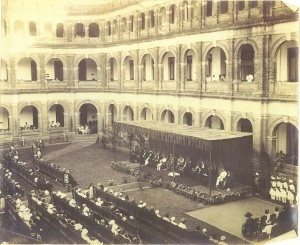
To hundreds of thousands of Indians the British Raj was personified by its administrative arm, the Indian Civil Service by which the British governed its imperial possession through a small élite spread thinly throughout the vast sub-continent.
The Indian Civil Service was a tiny administrative elite, never more than twelve hundred in number and, until the twentieth century, overwhelmingly British in composition. It was composed of those officers appointed under Section XXXII of the Government of India Act of 1858 to posts reserved for them alone. Officers were recruited by competitive examination at first held only in London but later also in Allahabad and the strength of the Service was restricted to the number 'absolutely necessary to fill the supervising and controlling offices' of the governing structure. The lower ranks of the administration were peopled by a vast army of subordinate clerks and provincial staff, recruited in India to do the more humdrum tasks. But the hierarchy was headed and guided by the well controlled hand of carefully selected ICS officers. These officers held all the key posts: they surrounded the Viceroy, they dominated the provincial governments and they were ultimately responsible for overseeing all government activity in the two hundred and fifty districts that comprised British India. (Source: http://www.historytoday.com/ann-ewing...)
More:
http://en.wikipedia.org/wiki/Imperial...
http://www.britishempire.co.uk/maproo...
http://sandpaper.bitsaa.org/archives/...
http://www.bl.uk/reshelp/findhelpregi...
http://www.indianetzone.com/60/histor...
http://www.bbc.co.uk/history/british/...
http://www.essaysinhistory.com/articl...
http://www.hindustantimes.com/punjab/...
http://www.h-net.org/reviews/showrev....
(no image)The future government of India and the Indian civil service; papers ed by Ernest Barker (no photo)
(no image)Indianization Of The Civil Services In British India, 1858 1935 by Malti Sharma (no photo)
 by L.S.S. O'Malley (no photo)
by L.S.S. O'Malley (no photo) by Clive Dewey (no photo)
by Clive Dewey (no photo) by Aroon Tikekar (no photo)
by Aroon Tikekar (no photo) by John William Kaye (no photo)
by John William Kaye (no photo)
 Thanks, Hana. There is so much out there about the Raj, and independence that it was hard to pick those books which would be of interest.
Thanks, Hana. There is so much out there about the Raj, and independence that it was hard to pick those books which would be of interest.
 The Jewel in the Crown, coupled with all the great resources here have me completely hooked on reading more about India and getting deeper into the Raj quartet.
The Jewel in the Crown, coupled with all the great resources here have me completely hooked on reading more about India and getting deeper into the Raj quartet.
Jill great job on the Glossary - we can add to this glossary for all of the Raj books and will have a substantial and very informative glossary for all. Thank you Jill.
I bet there will be. This is a fabulous series that I want to continue so all of this work is carried over.
 Hey Martin......I know we will see you participating in the read of the second book. Looking forward to it.
Hey Martin......I know we will see you participating in the read of the second book. Looking forward to it.
 Jill,
Jill,I haven't read this but have it on my India shelf. It was well received when first published in 2008 and may be a good fit under the Gandhi books you've compiled:
 by Arthur Herman (no photo)
by Arthur Herman (no photo)
 Jainism
Jainism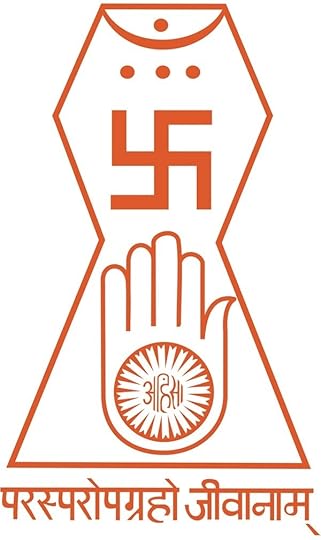
Jainism /ˈdʒeɪnɪz(ə)m/, traditionally known as Jaina dharma,is an Indian religion that prescribes a path of non-violence towards all living beings and emphasizes spiritual independence and equality between all forms of life. Practitioners believe that non-violence and self-control are the means by which they can obtain liberation. Currently, Jainism is divided into two major sects —Digambara and Śvētāmbara.
The word Jainism is derived from a Sanskrit verb Jin which means to conquer. It refers to a battle with the passions and bodily pleasures that the jaina ascetics undertake. Those who win this battle are termed as Jina (conqueror). The term Jaina is therefore used to refer to laymen and ascetics of this tradition alike.
Jainism is one of the oldest religions in the world. Jains traditionally trace their history through a succession of twenty-four propagators of their faith known as tirthankara with Ādinātha as the first tirthankara and Mahāvīra as the last of the current era. For long periods of time Jainism was the state religion of Indian kingdoms and widely adopted in the Indian subcontinent. The religion has been in decline since the 8th century CE due to the growth of, and oppression by the followers of Hinduism, and Islam.
Jainism is a religious minority in India, with 4.2 million adherents, and there are small but notable immigrant communities in Belgium, Canada, Hong Kong, Japan, Singapore, and the United States. Jains have the highest degree of literacy of any religious community in India (94.1 percent), and their manuscript libraries are the oldest in the country. (Source: http://en.wikipedia.org/wiki/Jainism)
More:
http://www.bbc.co.uk/religion/religio...
http://www.beliefnet.com/Faiths/2001/...
http://www.cs.colostate.edu/~malaiya/...
http://www.britannica.com/EBchecked/t...
http://www.jainism.org/
religionfacts.com/jainism/index.htm
 by Jeffery D. Long (no photo)
by Jeffery D. Long (no photo) by Tara Sethia (no photo)
by Tara Sethia (no photo) by M.S. Abhinandan (no photo)
by M.S. Abhinandan (no photo) by Michael Tobias(no photo)
by Michael Tobias(no photo) by Aidan D. Rankin (no photo)
by Aidan D. Rankin (no photo) by Sinclair Stevenson (no photo)
by Sinclair Stevenson (no photo) by
by
 Edward Thomas
Edward Thomas
 Martin wrote: "Jill,
Martin wrote: "Jill,I haven't read this but have it on my India shelf. It was well received when first published in 2008 and may be a good fit under the Gandhi books you've compiled:
[bookcover:Gandhi and Chur..."
Thanks, Martin.
 Sikhs
Sikhs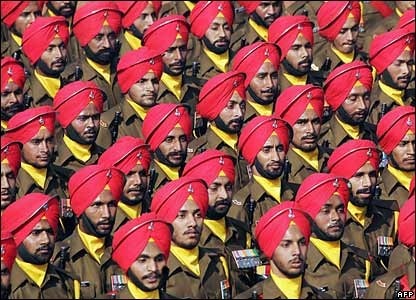
A way of life and philosophy well ahead of its time when it was founded over 500 years ago, The Sikh religion today has a following of over 20 million people worldwide. Sikhism preaches a message of devotion and remembrance of God at all times, truthful living, equality of mankind, social justice and denounces superstitions and blind rituals. Sikhism is open to all through the teachings of its 10 Gurus enshrined in the Sikh Holy Book and Living Guru, Sri Guru Granth Sahib.
Who and What is a Sikh?
The word 'Sikh' in the Punjabi language means 'disciple', Sikhs are the disciples of God who follow the writings and teachings of the Ten Sikh Gurus. The wisdom of these teachings in Sri Guru Granth Sahib are practical and universal in their appeal to all mankind.
"I observe neither Hindu fasting nor the ritual of the Muslim Ramadan month; Him I serve who at the last shall save. The Lord of universe of the Hindus, Gosain and Allah to me are one; From Hindus and Muslims have I broken free. I perform neither Kaaba pilgrimage nor at bathing spots worship; One sole Lord I serve, and no other. I perform neither the Hindu worship nor the Muslim prayer; To the Sole Formless Lord in my heart I bow. We neither are Hindus nor Muslims; Our body and life belong to the One Supreme Being who alone is both Ram and Allah for us." (Guru Arjan Dev, Guru Granth Sahib, Raga Bhairon pg. 1136)
"Any human being who faithfully believes in: (i) One Immortal Being, (ii) Ten Gurus, from Guru Nanak to Guru Gobind Singh, (iii) The Guru Granth Sahib, (iv) The utterances and teachings of the ten Gurus and, (v) the baptism bequeathed by the tenth Guru, and who does not owe allegiance to any other religion is a Sikh." (Rehat Maryada, Sikh Code of Conduct)
Philosophy and Beliefs
There is only One God. He is the same God for all people of all religions.
The soul goes through cycles of births and deaths before it reaches the human form. The goal of our life is to lead an exemplary existence so that one may merge with God. Sikhs should remember God at all times and practice living a virtuous and truthful life while maintaining a balance between their spiritual obligations and temporal obligations.
The true path to achieving salvation and merging with God does not require renunciation of the world or celibacy, but living the life of a householder, earning a honest living and avoiding worldly temptations and sins.
Sikhism condemns blind rituals such as fasting, visiting places of pilgrimage, superstitions, worship of the dead, idol worship etc.
Sikhism preaches that people of different races, religions, or sex are all equal in the eyes of God. It teaches the full equality of men and women. Women can participate in any religious function or perform any Sikh ceremony or lead the congregation in prayer.
History and Practices
The founder of the Sikh religion was Guru Nanak who was born in 1469. He preached a message of love and understanding and criticized the blind rituals of the Hindus and Muslims. Guru Nanak passed on his enlightened leadership of this new religion to nine successive Gurus. The final living Guru, Guru Gobind Singh died in 1708.
During his lifetime Guru Gobind Singh established the Khalsa order (meaning 'The Pure'), soldier-saints. The Khalsa uphold the highest Sikh virtues of commitment, dedication and a social conscious. The Khalsa are men and women who have undergone the Sikh baptism ceremony and who strictly follow the Sikh Code of Conduct and Conventions and wear the prescribed physical articles of the faith. One of the more noticeable being the uncut hair (required to be covered with a turban for men) and the Kirpan (ceremonial sword).
Before his death in 1708 Guru Gobind Singh declared that the Sikhs no longer needed a living and appointed his spiritual successor as Sri Guru Granth Sahib, his physical successor as the Khalsa. Guru Gobind Singh felt that all the wisdom needed by Sikhs for spiritual guidance in their daily lives could be found in Sri Guru Granth Sahib, the Eternal Guru of the Sikhs. Sri Guru Granth Sahib is unique in the world of religious scriptures because not only is it accorded the status of being the spiritual head of the Sikh religion, but besides the poetry of the Gurus, it also contains the writings of saints of other faiths whose thoughts were consistent with those of the Sikh Gurus.
Sikhism does not have priests, which were abolished by Guru Gobind Singh. The Guru felt that they had become corrupt and full of ego. Sikhs only have custodians of the Guru Granth Sahib (granthi), and any Sikh is free to read the Guru Granth Sahib in the Gurdwara (a Sikh temple) or in their home. All people of all religions are welcome to the Gurdwara. A free community kitchen can be found at every Gurdwara which serves meals to all people of all faiths. Guru Nanak first started this institution which outline the basic Sikh principles of service, humility and equality.
The most significant historical religious center for the Sikhs is Harmiandir Sahib (The Golden Temple) at Amritsar in the state of Punjab in northern India. It is the inspirational and historical center of Sikhism but is not a mandatory place of pilgrimage or worship. All places where Sri Guru Granth Sahib are installed are considered equally holy for Sikhs.(Source: http://www.sikhs.org/summary.htm)
More:
http://www.sikhs.org/
https://www.sikhnet.com/
http://www.unitedsikhs.org/
http://en.wikipedia.org/wiki/Sikh
http://www.sikhfederation.com/
http://www.beliefnet.com/Faiths/Sikhi...
http://sikhcouncilusa.org/
http://sacred-texts.com/skh/index.htm
http://www.sikhismguide.org/
 by Joseph Davey Cunningham (no photo)
by Joseph Davey Cunningham (no photo) by Knut A Jacobsen(no photo)
by Knut A Jacobsen(no photo) by Raghu Rai (no photo)
by Raghu Rai (no photo) by Patwant Singh (no photo)
by Patwant Singh (no photo) by Dorothy Field (no photo)
by Dorothy Field (no photo) by Patwant Singh (no photo)
by Patwant Singh (no photo) by J.S. Grewal(no photo)
by J.S. Grewal(no photo) by T.S. Randhawa (no photo)
by T.S. Randhawa (no photo) by
by
 Khushwant Singh
Khushwant Singh by
by
 Khushwant Singh
Khushwant Singh
 Kasturba Gandhi
Kasturba Gandhi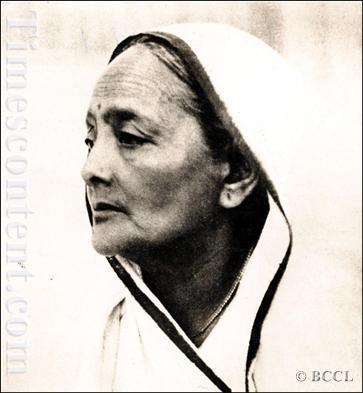
Kasturba Gandhi, known affectionately as Ba, was married to Mohandas Gandhi in 1882 when she was but thirteen years old. When Gandhi left for London in 1888, she did not accompany him: she was already a mother, since Harilal had been born earlier that year. Manilal was born to them in 1892; Ramdas followed in 1897, and Devadas, the last of their four sons, was born in 1900. In 1906, Gandhi decided to observe brahamacharya, or observe the vow of chastity: and thereafter Mohandas and Kasturba never had any sexual relations. Gandhi himself wrote that Kasturba eagerly assented to his decision to take a vow, but we do not have this from her own mouth, and some modern feminist readings have taken this an instance of Gandhi's overbearing attitudes.
It is unequivocally clear, however, that Kasturba worked alongside her husband. When Gandhi became involved in the agitation to improve working conditions for Indians in South Africa and give them the power to represent themselves, Kasturba eventually decided to join the struggle. In September 1913, she was arrested, and sentenced to three months' imprisonment at hard labor. On numerous subsequent occasions in India, she took Gandhi's place when he was under arrest, and was always closely associated with the struggle in India, giving encouragement to women volunteers.
Kasturba was to develop into a very considerable figure in her own right, but sadly she has scarcely received the attention she deserves. She showed an independence of spirit, and Gandhi's autobiography records an incident when he was almost tempted, in a moment of acute anger, to throw her out of the home. He had asked that she should contribute, as did everyone else at their ashram, to menial tasks; and though she agreed, she balked at having to clean the toilets, and flatly refused to do so. There were also disagreements between them on the care of their sons, whom Kasturba (like some others) was inclined to believe had been neglected by their father. Gandhi, on the other hand, took the view that as his sons, they were entitled to no special privileges. Harilal, in particular, caused her great sorrow, and when he once arrived at her bedside during her last illness, she burst into tears.
Mohandas and Kasturba remained married for sixty-two years, but it is one of the marriages about which we know very little, though Gandhi's own life has been recorded in excruciatingly minute detail. We do not really know, for example, how she received the presence of other women who were to become Gandhi's followers and devotees, to the point where they, rather than Kasturba, attended to his daily needs. Yet this very question presumes the centrality of the husband-wife nexus over all others, and this may be a way of approaching questions that have had little resonance in Indian culture. Contemporary witnesses have testified to the extraordinary bonds of affection between them. Following the 'Quit India' movement, Kasturba joined her husband in detention at the Aga Khan's Palace in Poona. It is there that she died in 1944; Gandhi was at her bedside, and a picture taken just after her death shows Gandhi huddled in a corner, a pale shadow of himself.(Source: https://www.sscnet.ucla.edu/southasia...)
More:
http://en.wikipedia.org/wiki/Kasturba...
http://www.sahistory.org.za/people/ka...
http://www.mkgandhi.org/students/anec...
http://www.britannica.com/EBchecked/t...
http://www.rarenewspapers.com/view/58...
http://www.iloveindia.com/indian-hero...
http://www.gandhi-manibhavan.org/kast...
http://dhenkanal.nic.in/ssa/KGBV.htm
(no image)Kasturba Gandhi: The Saga of Satyagraha by S. R. Bakshi (no photo)
(no image) Kasturba: A Life by Arun Gandhi(no photo)
(no image)Gandhi's Children by Trevor Fishlock(no photo)
 by Sushila Nayyar(no photo)
by Sushila Nayyar(no photo) by Nimeran Sahukar (no photo)
by Nimeran Sahukar (no photo) by Arun Gandhi (no photo)
by Arun Gandhi (no photo)
 India During British Rule
India During British Rule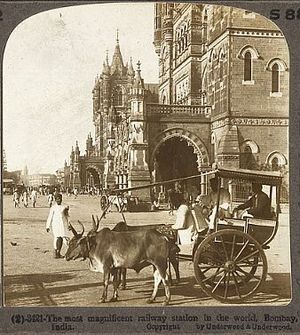
British rule from the time after the mutiny is often called the Raj. During this period a tiny number of British officials and troops (about 20,000 in all) ruled over 300 million Indians. This was often seen as evidence that most Indians accepted and even approved of British rule. There is no doubt that Britain could not have controlled India without the co-operation of Indian princes and local leaders, as well as huge numbers of Indian troops, police officers, civil servants etc.
Other historians point out that British rule of India was maintained by the fact that Indian society was so divided that it could not unite against the British. In fact, the British encouraged these divisions. The better-off classes were educated in English schools. They served in the British army or in the civil service. They effectively joined the British to rule their poorer fellow Indians. There are huge arguments about whether the British created or enlarged these divisions in Indian society (British society was deeply divided by class), or whether the British simply took advantage of divisions that were already present in Indian society. For much of the 1800s the average Indian peasant had no more say in the way he or she was ruled than did the average worker in the United Kingdom.
The British view tended to portray British rule as a charitable exercise - they suffered India's environment (eg climate, diseases) in order to bring to India good government and economic development (eg railways, irrigation, medicine). Modern admirers of British rule also note these benefits.
Other historians point out that ruling India brought huge benefits to Britain. India's huge population made it an attractive market for British industry. In the 1880s, for example, about 20% of Britain's total exports went to India. By 1910 these exports were worth £137 million. India also exported huge quantities of goods to Britain, especially tea, which was drunk or exported on from Britain to other countries. Then there were the human resources. The Indian army was probably Britain's single greatest resource. Around 40% of India's wealth was spent on the army. This army was used by Britain all over the world, including the wars in South Africa in 1899-1902 and the First and Second World Wars. It was the backbone of the power of the British empire. In 1901, for example, the British viceroy (governor) of India, Lord Curzon, said 'As long as we rule India, we are the greatest power in the world. If we lose it we shall straightway drop to a third rate power'. (Source: http://www.nationalarchives.gov.uk/ed...)
More:
http://www.flowofhistory.com/units/em...
http://www.dailymail.co.uk/debate/art...
http://www.parliament.uk/about/living...
http://rsfnational.wordpress.com/misc...
http://www.ucalgary.ca/hic/files/hic/...
http://www.essaysinhistory.com/articl...
http://www.newstatesman.com/asia/2009...
 by Clive Dewey(no photo)
by Clive Dewey(no photo) by Judith E. Walsh(no photo)
by Judith E. Walsh(no photo) Andrew H.L. Fraser (no photo)
Andrew H.L. Fraser (no photo) by Peter van der Veer (no photo)
by Peter van der Veer (no photo) by Joyce Chapman Lebra (no photo)
by Joyce Chapman Lebra (no photo) by Margaret MacMillan (no photo)
by Margaret MacMillan (no photo) by
by
 Richard Holmes
Richard Holmes by
by
 Flora Annie Steel
Flora Annie Steel
 Important facts and objective questions on Governor General and Viceroys in British India-
Important facts and objective questions on Governor General and Viceroys in British India-http://playquiz2win.com/tothepoint/gk...
 Sepoy
Sepoy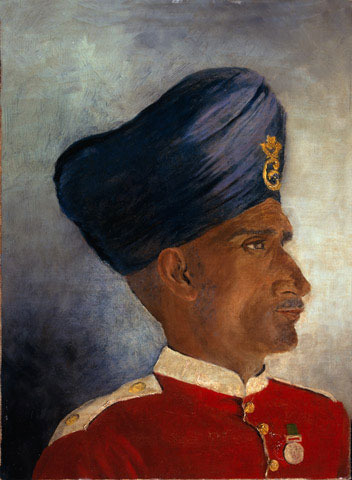
The term "sepoy" or "sipāhi" is derived from the Persian word "sipāh" meaning "infantry soldier" in the Mughal Empire. In the Ottoman Empire the term Sipahi was used to refer to elite cavalry troopers. In its most common application sepoy was the term used in the British Indian Army, and earlier in that of the British East India Company, for an infantry private (a cavalry trooper was a sowar).
The term sepoy came into use in the forces of the British East India Company in the eighteenth century, where it was one of many, such as peons, gentoos, mestees and topasses used for various categories of native soldiers. Initially it referred to Hindu or Muslim soldiers without regular uniform or discipline. It later generically referred to all native soldiers in the service of the European powers in India. Close to ninety-six percent of the British East India Company's army of 300,000 men were native to India and these sepoys played a crucial role in securing the subcontinent for the company.
Initially the British recruited sepoys from the local communities in the Madras and Bombay Presidencies, the emphasis being on recruits having adequate physique and being of sufficient caste. In the Bengal Army however, recruitment was only amongst high caste Brahman and Rajput communities, mainly of the Uttar Pradesh and Bihar regions. Recruitment was undertaken locally by battalions or regiments often from the same community, village and even family. The commanding officer of a battalion became a form of substitute for the village chief or gaon bura. He was the mai-baap or the "father and mother" of the sepoys making up the paltan ("unit"). There were many family and community ties amongst the troops and numerous instances where family members enlisted in the same battalion or regiment. The izzat ("honour") of the unit was represented by the regimental colours; the new sepoy having to swear an oath in front of them on enlistment. These colours were stored in honour in the quarter guard and frequently paraded before the men. They formed a rallying point in battle. The oath of fealty by the sepoy was given to the East India Company and included a pledge of faithfulness to the salt that one has eaten.
The salary of the sepoys employed by the East India Company, while not substantially greater than that paid by the rulers of Indian states, was usually paid regularly. Advances could be given and family allotments from pay due were permitted when the troops served abroad. There was a commisariat and regular rations were provided. Weapons, clothing and ammunition were provided centrally, in contrast to the soldiers of local kings whose pay was often in arrears. In addition local rulers usually expected their sepoys to arm themselves and to sustain themselves through plunder.
This combination of factors led to the development of a sense of shared honour and ethos amongst the well drilled and disciplined Indian soldiery who formed the key to the success of European feats of arms in India and abroad.
Following the Indian Rebellion of 1857 the surviving East India Company regiments were merged into a new Indian Army under the direct control of the British Crown. The designation of "sepoy" was retained for Indian soldiers below the rank of lance-naik, except in cavalry where the equivalent ranks were sowar or "trooper". (Source: http://en.wikipedia.org/wiki/Sepoy)
More:
http://asianhistory.about.com/od/glos...
http://eresources.nlb.gov.sg/infopedi...
http://ageofempires.wikia.com/wiki/Sepoy
http://iris.lib.neu.edu/cgi/viewconte...
http://www.twcenter.net/wiki/Sepoys_%...
http://dissention.wordpress.com/2013/...
http://www.peashooter85.com/post/3648...
http://www.thenagain.info/webchron/in...
(no image)Volunteering in India; Or, an Authentic Narrative of the Military Services of the Bengal Yeomanry Cavalry During the Indian Mutiny, and Sepoy War by John Tulloch Nash (no photo)
 by Major Gordon Corrigan(no photo)
by Major Gordon Corrigan(no photo) by Seema Alavi(no photo)
by Seema Alavi(no photo) by Shaswati Mazumdar (no photo)
by Shaswati Mazumdar (no photo) by Edmund Candler (no photo)
by Edmund Candler (no photo) by Gajendra Singh (no photo)
by Gajendra Singh (no photo) by George William Forrest(no photo)
by George William Forrest(no photo)
Books mentioned in this topic
Staying On (other topics)The Making of Pakistan: A Study in Nationalism (other topics)
Jinnah of Pakistan (other topics)
National Symbols of Pakistan: Urdu, Indus River, State Emblem of Pakistan, Muhammad Ali Jinnah, Star and Crescent, Snow Leopard (other topics)
Muhammad Ali Jinnah (other topics)
More...
Authors mentioned in this topic
K.K. Aziz (other topics)Source Wikipedia (other topics)
Books LLC (other topics)
Ayesha Jalal (other topics)
Jesse Russell (other topics)
More...









The Jewel in the Crown - Book One
The Day of the Scorpion - Book Two
The Tower of Silence - Book Three
A Division of the Spoils - Book Four
Staying On - Man Booker Prize - 1977